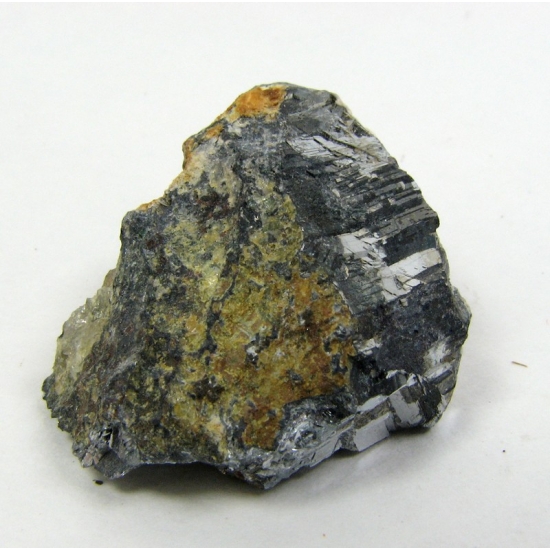Dissolutions: OBORO/Perte de Signal 2016
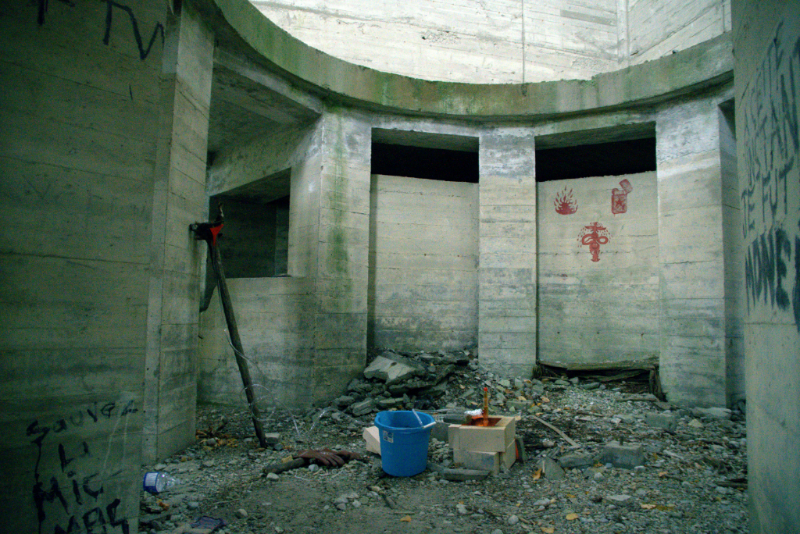
1 -
http://www.oboro.net/en/activity/dissolutions
Decoding ancient alchemical texts and emblems as (literal) instructions for the construction, execution and maintenance of a contemporary, geomantic and necessarly ouroboric live processor…
Table of Contents
- 1. -
- 2. the three emblems
- 3. computation
- 4. semiconductor
- 5. dissolution
- 6. materials notes
- 7. equipment/apparatus notes
- 8. fieldtrips
- 9. processes TODO
- 10. references
- 11. questions/directions
- 11.1. - 3 layers in cosmic retort and key emblem // 3 diagrams also
- 11.2. how might antimony via humida/vinegar/acetate path relate to thin film dep?
- 11.3. how could a leaky, light/dark binary taped Turing machine operate? how easy would it be to build a prototype?
- 11.4. Aspergillus niger?
- 11.5. constellations and antimony: regulus // and Corvus/crow (in Virgo) -> geomantic processor
- 11.6. glass/mirrors
- 11.7. using our own breath as distillation or circulation medium for minerals - possibly for workshop!
- 12. diagrams
- 13. software notes
- 14. for a reader
- 15. working group
- 16. workshop/s and calls
- 17. exhibition
- 18. documentation
- 19. credits
Let the waters above the heavens fall
and the earth will yield its fruit
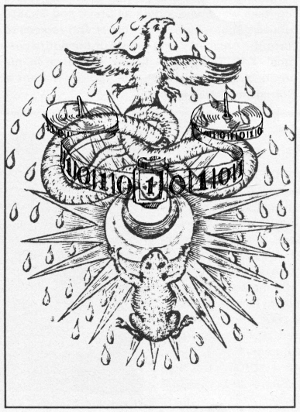

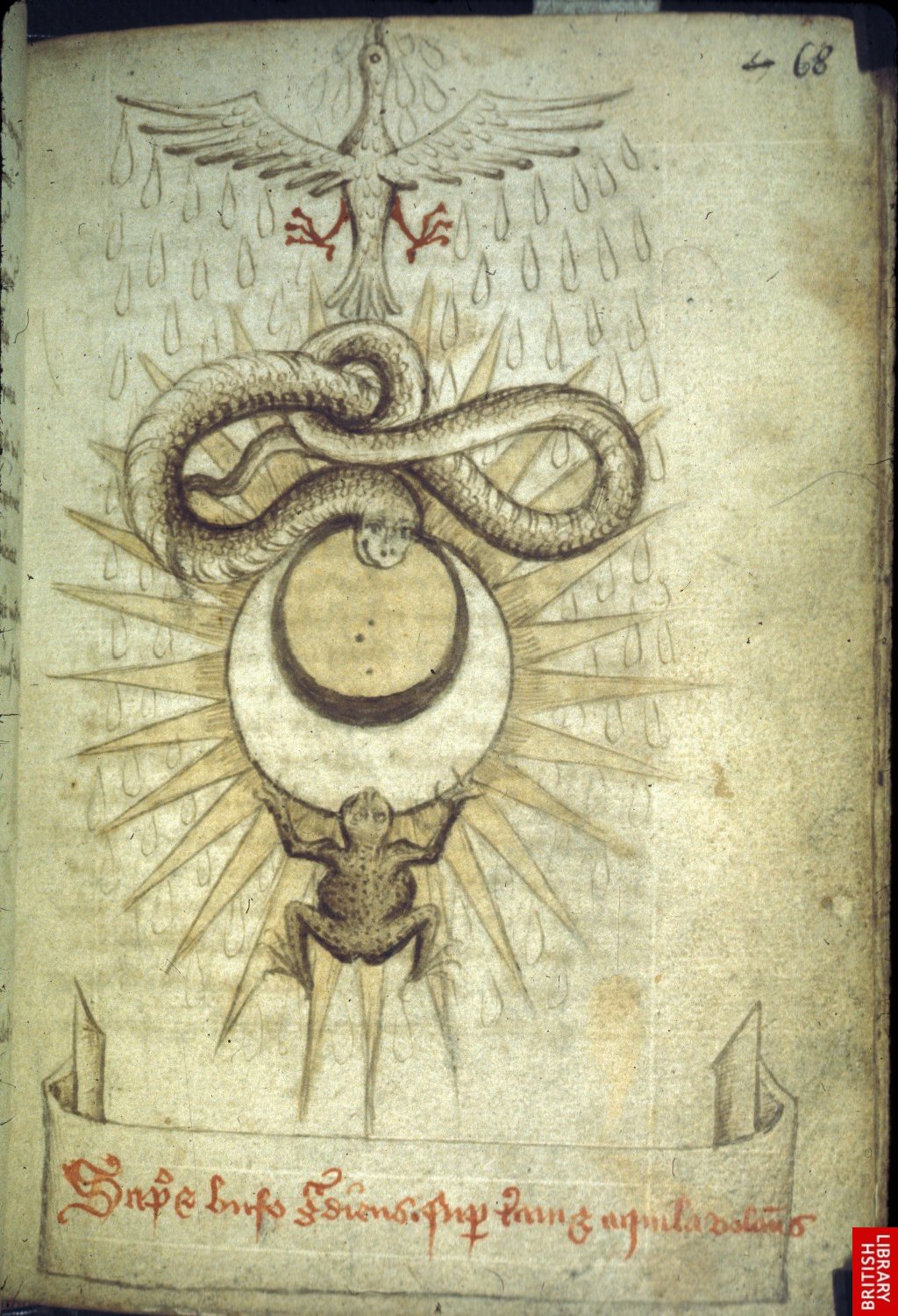
"Serpents et Bufo gradiens super terram, Aquila volans" It means: "A serpent and a toad coming up above the earth, a flying eagle"
Longer version: "A serpent and a toad coming up above the earth (literally ' stepping up above,') is our Magistery."
British Library (BL) MS Harley 2407 f.68: http://www.bl.uk/catalogues/illuminatedmanuscripts/record.asp?MSID=3670
This is our key emblem for the work.
Forming the front page/cover of Ashmole's Theatrum Chemicum Brittanicum (TCB) as engraved by Robert Vaughan:
Earlier in 2407 f.15v:

See: http://www.levity.com/alchemy/toad.html - summary?
Another version is in 2407 f.57v which is also copied in Egerton (BL Ms 845 f.15v-16): http://www.bl.uk/catalogues/illuminatedmanuscripts/record.asp?MSID=9134&CollID=28&NStart=845
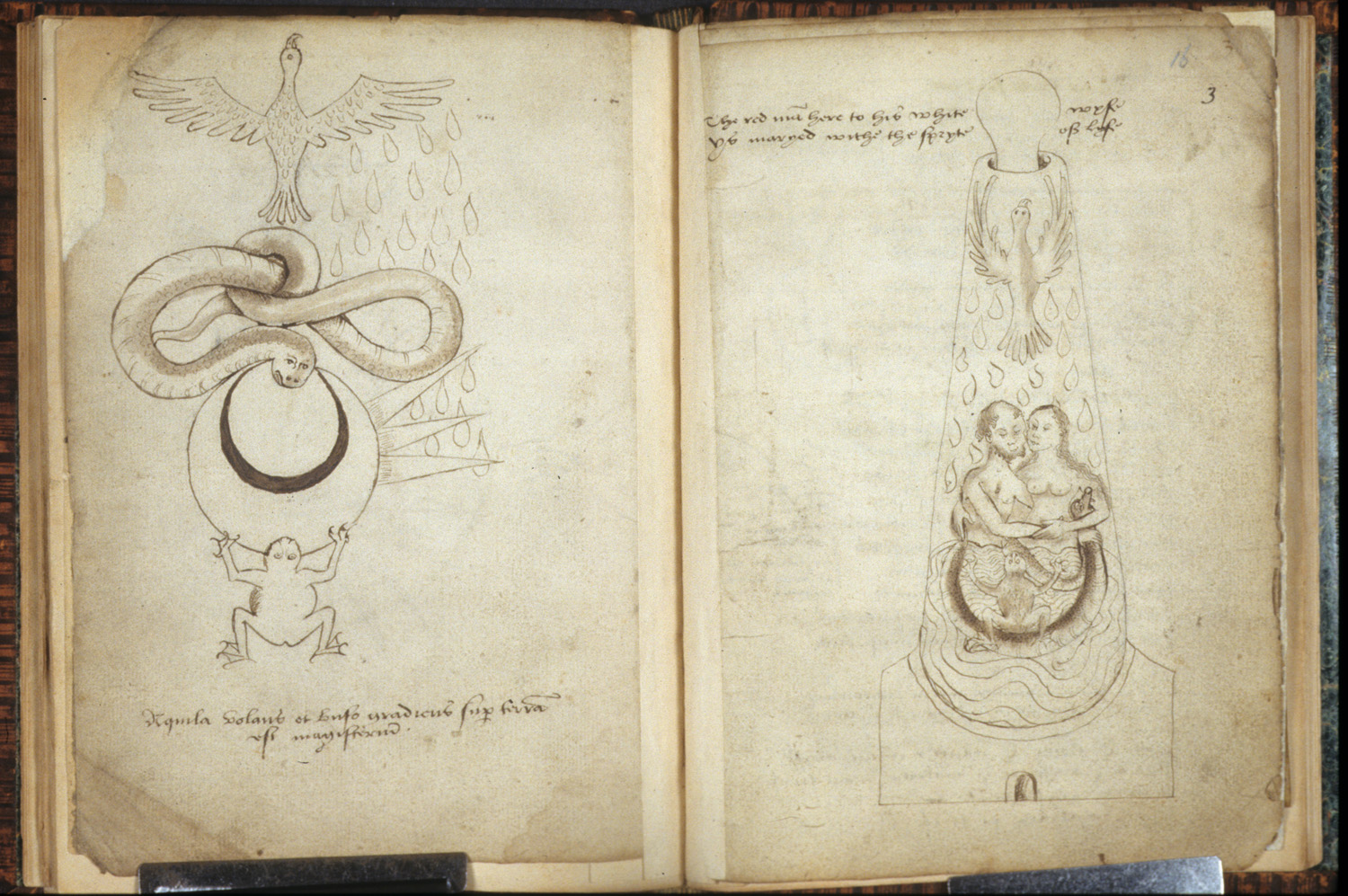
"The red man here to his white wyfe, Ys maryed with the spryte of life"
See also:
TCB:
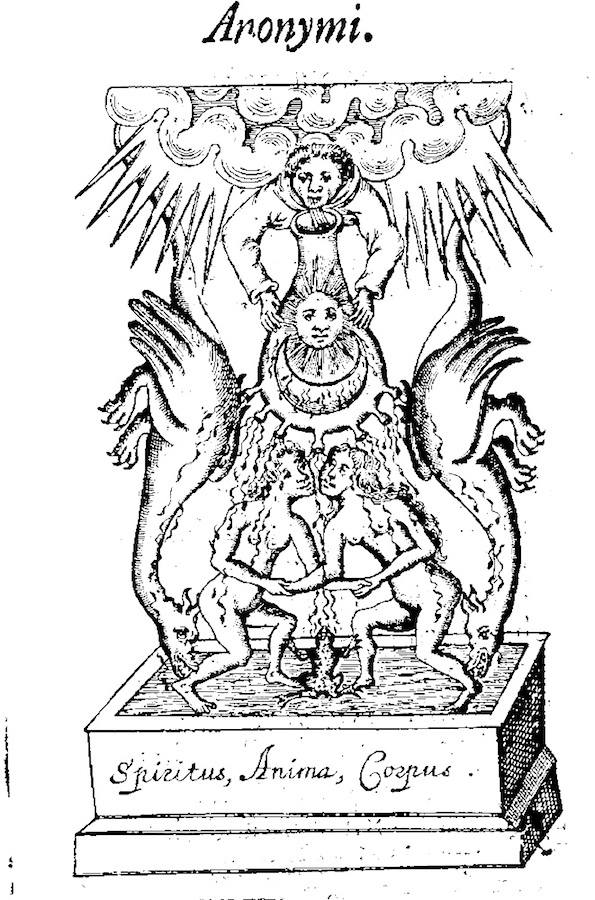
Sloane 1171: http://www.bl.uk/catalogues/illuminatedmanuscripts/record.asp?MSID=1217 (which also has version of man and woman in flask)

We can also compare this to first image from The Ripley Scrowl:

… the first roundel has a scroll attached to it saying “Prima Materia” (Latin for “First Matter”). The Latin words around this key image are:Anima (“psyche” or “soul”). Corpus (“body”). Spiritus (“spirit”). These are sometimes known as “Sulphur” (Red), “Salt” (Black) and “Mercury” (White).
From: http://noise-vs-signal.tumblr.com/post/112274242878/details-from-a-ripley-scroll-of-which-there-are
See also: https://www.academia.edu/5034617/Open_Secrets_Alchemical-Hermetic_Imagery_In_the_Ripley_Scrolls
(in Abraxas)
2 the three emblems
Which refer to the three levels of the key above (from top: 1]bird, 2]serpent/worm, 3]toad/earth).
2.1 Mutus Liber Plate 9


- Acid rain. In tears. Acid from air/lightning. 1-DISTILLATION Bird/eagle/raven
A common example is nitric acid produced by electric discharge in the atmosphere such as lightning. Acid deposition as an environmental issue would include additional acids to H2CO3.
2.2 Basil Valentine. First Key
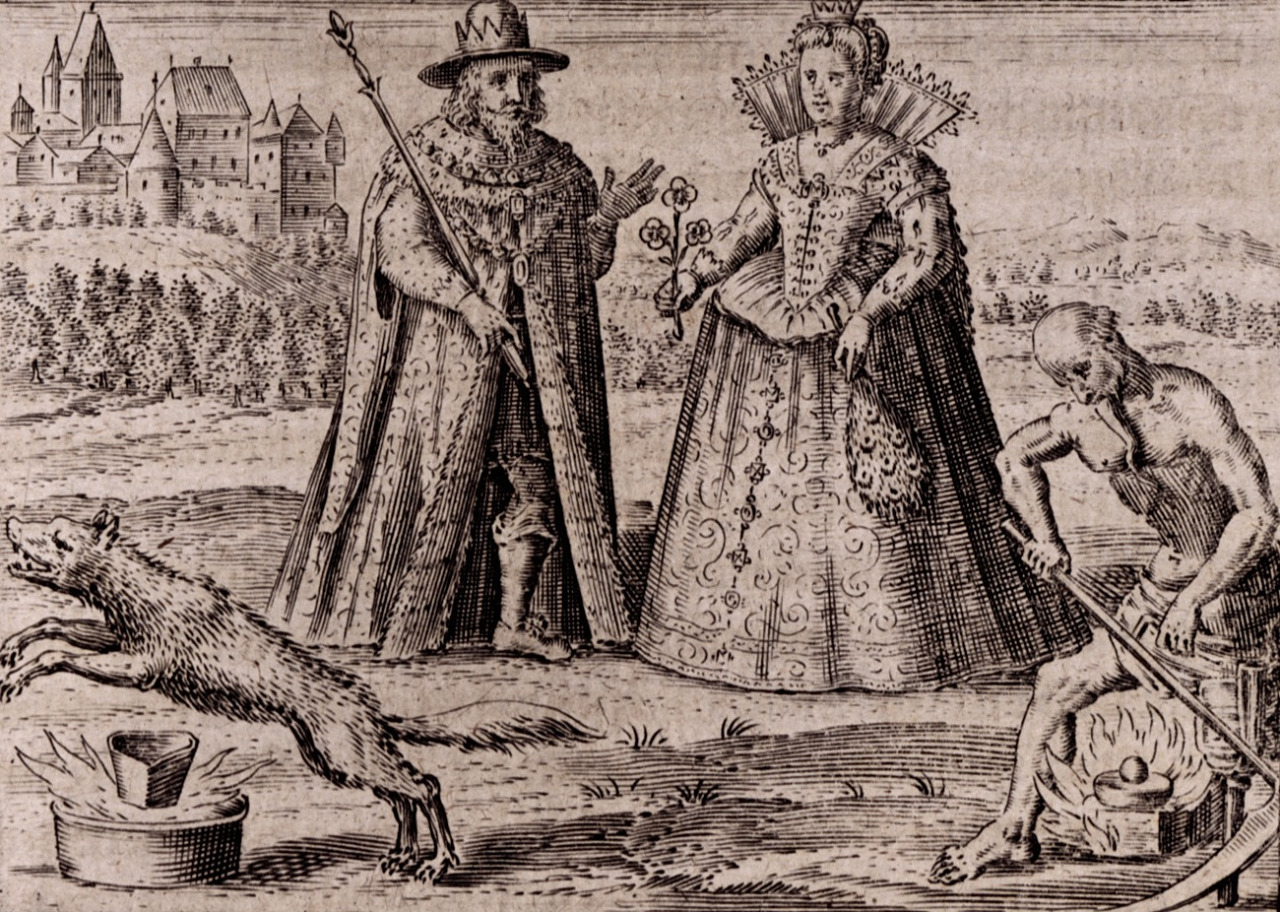

- Antimony sulfide and gold CPU/semiconductor. 2-CONTROL/EXECUTION serpent/ouroboric cycle
- The geomantic processor runs software which displays and which controls its own dissolution. It eats itself, it controls itself as this eating.
- The worm. The first computer worm _ The Shockwave Rider.
- The semiconductor junction eats itself.
[See also Petrinus. The Great Alchemical Work. p.69+ ]
- a version of which is here: http://icanseefar.tripod.com/key1.htm:
A King on the left side and a Queen on the right standing in an open landscape. The King holds a sceptre in his right hand and the Queen holds a three-blossomed flower in her right hand and a peacock feather fan in her left. In front of the King a wolf or jumps over a triangular crucible placed on a basin of fire. In front of the Queen, and old man with a scythe and crippled leg (a Saturn figure) steps across a fire on which a vessel (Cupel) is being heated.
Mr.Canseliet in French edition, "Les Douze Clefs De la Philosophie", comment the first figure as following:
«The King and the Queen of the Work, that is, the gold and the philosophical silver, spagyricaly designated by the wolf and the great metallic button on the cupel.
This and the crucible in the middle of the flames, indicate clearly the dry way, in which represents a great place the secret fire…»
Albert Poisson in his book Théories & Symboles Des Alchimistes, p 87 says:
«The gold and the purified silver constitute the remote stone matter. The Sulphur is extracted from gold, the Mercury from silver, being the closer matter.»
Report us now to the text of First Key in its more essential parts:
«Everything that is obtained from the mines has its value unless, indeed, it is adulterated.»
«Let the diadem of the King be of pure gold and let the Queen that is united to him in wedlock be chaste and immaculate.»
«Let my friend know that no impure or spotted things useful form our purpose. For there is nothing in their leprous nature capable of advancing the interest of our Art. There is much more likelihood of that which is in itself good being spoiled by that which is impure. Everything that is obtained from mines has its value, unless, indeed, it is adulterated. Adulteration, however, spoils its goodness and its efficacy.»
«As the physician purges and cleanses the inward parts of the body and removes all unhealthy matter by means of his medicines, so our metallic substances must be purified and refined of all foreign matter in order to ensure the success of our task. Therefore, our Masters requires a pure, immaculate body that is untainted with any foreign admixture, which admixture is the leprosy of our metals.»
«Let the diadem of the King be of pure gold and let the Queen that is united to him in wedlock be chaste and immaculate.»
«If you would operate by means of our bodies, take a fierce grey wolf, which though on account of its name it be subject to the sway of warlike Mars, is by birth the offspring of ancient Saturn, and found in the valleys and mountains of the world, where he roams about savage with hunger. Cast to him the body of the King, and when he has devoured it, burn him entirely to ashes in a great fire. By this process the King will be liberate; and when it been performed thrice the Lion has overcome the wolf, and will find nothing more to eat in him. Thus our Body has been rendered fit for first stage of our work.»
«The King travels through six regions in the heavenly firmament, and in the seven he fixes his abode.»
Having in account that the commentator says and also Albert Poisson in reference of the figures of woodcut, everything would take us to conclude that the King represents the gold that will be purified by the Wolf and the Queen the silver also it purified by Saturn on the cupel, as one can see for the metallic button. This purification process of the two noble metals was very usual in that time.
This is a possible interpretation which to the first view, it seems the most appropriate and for a long time we accept it but with reservation.
If you read carefully the text of this first key, you will see that the Master does not make any reference to the purification of the Queen. He refers, just, to the King’s purification and of there our doubt.
Never accept willing the comments of the translator and commentator, (French edition) author of several books about our Art, that we respected to much, because they are not agree with the text and we find very strange that he did not make that repair.
Later, we acquire Basil Valentine’s last published book, "Le Dernier Testament" (The Will and Last Testament). As the title indicates, probably, it will have been one of the last ones, Master’s book and perhaps that, one of the most generous and clear.
In referred book, we confirmed our reservation because the Master describes in clear language some of the keys of his book "The Twelve Keys" that, in the original, as we saw, are described in symbolic language.
Let us see, then, what the Master says on the First Key, in p 215 (French edition):
«The First Key teaches to seek, if you want, your seed in a being or metallic substance that is the gold…
The purification of the gold is made so that it is beaten well slim and very thin, then, molten and melted three times for the antimony, that after the King melted with antimony steady in the bottom, be recast before to be blown with very strong fire and then, purified by Saturn.
Then, you will find the most splendid, more beautiful and highly more brilliant gold that one can want, similar to the clear radiance of the Sun and very pleasant aspect…»
The text is clear and it does not place to any doubts. Only the King and just the King it is purified by the antimony or grey Wolf (the wolf jumping over the crucible) and, then, gone by the Cupel by means of Saturn (the old with a crippled leg with a scythe), having a cupel under with a metallic button of purified gold as shows the illustration. As Key text refers, Saturn it is the seventh city in the Celestial firmament (seventh alchemic planet). The Wolf, represent symbolically the antimony and Saturn the lead.
Now I ask yours: Why in the figure of First Key the King and Queen they are together if in the text the Queen has not any role?
«Let the diadem of the King be of pure gold and let the Queen that is united to him in wedlock be chaste and immaculate.»
Where in part of the text he said that the Queen is united to the King when and how? Nowhere.
Only the King is purified three times (the three flowers) by antimony in a crucible and after by lead in the Cupel as you can read in text.
In the Second Key we will see why.
Rubellus Petrinus
2.3 Aurora Consurgens. Cosmic retort


[the latter from Ripley scrowl]
Total process. Dissolution. Digestion. Containment and leakage. The vessel is the one work (ref? - and also that chemically it plays a part - see Principe below)
see: https://aras.org/concordance/content/aspects-alchemical-vessel (from Jung: Alchemical Studies)
also… in the Rosarium, "There is one stone, one medicine, one vessel, one method, one disposition, " or in the Philosophia reformata, "In our water all modes of things are brought about….In the said water they are made as in an artificial vessel, which is a mighty secret." The Golden Tract depicts this vessel as "the true philosophical Pelican"
But maybe is same as opening key emblem but here we have it as 3-VESSEL/DIGESTION as mining biotope toad/earth
2.4 others
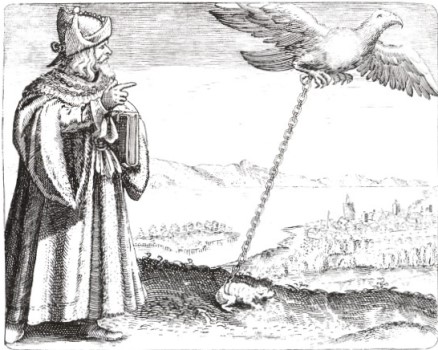
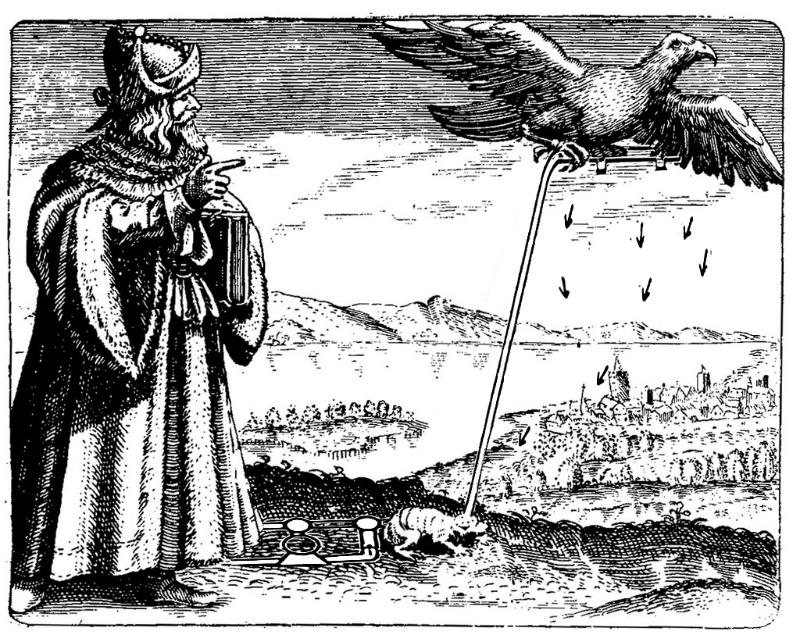
[Michael Maier’s Symbola Aureae mensae, 1617 (also in Stolcius - Viradarium Chymicum]
De Rola’s comment is “The Volatization of the Fixed, and the Fixation of the Volatile, constitute the whole of the Work” (p. 114). He also observes that the alchemist looking on is Avicenna. Fabricius, in his discussion of the engraving, quotes Maier’s commentary on the engraving: “The eagle flying through the air and the toad crawling on the ground are the magistry” (Alchemy, p. 55).
Join together an earthly toad and a flying eagle; you see the magesterium in our art. [Stolcius?]
Toad and eagle/crow chained together: http://www.levity.com/alchemy/toad.html
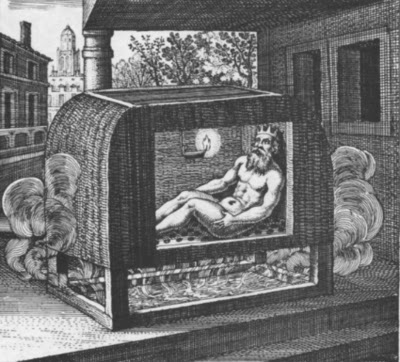
The sunken king of alchemy went on living as the "metal king", the "regulus" of metallurgy.
The king sinking in the sea is the arcane substance, which Maier calls the "antimony of the philosophers." [ref. Symb. Aur. mensae: "The true antimony of the philosophers [lies] in the deep sea, that the son of the king may lurk submerged"]
[Above from Jung. Mysterium Coniunctionis p. 332+]
The sunken king is the earth or planet under technology. [Image more as engulfed version also of below from Book of Lambspring - http://www.levity.com/alchemy/lambtext.html]

3 computation
3.1 control
- of flows - of heat/energy (as) electricity, water, air
3.1.1 measurement of heat for example…
- We have thermocouple with MAX6675 into Arduino MEGA 1280 (Mega 2560 and select Tools/Processor
5 pins - 45-53 at edge of Arduino
https://github.com/adafruit/MAX6675-library copied into ~/Downloads/arduino-1.6.12/libraries and then select Include Library
- Sketch after: http://www.instructables.com/id/Arduino-and-Thermocouple-K-MAX6675/step3/Coding-like-a-pro/
int thermo_gnd_pin = 45; int thermo_vcc_pin = 47; int thermo_so_pin = 53; int thermo_cs_pin = 51; int thermo_sck_pin = 49;
- prints to serial (set serial port)
3.2 entropy
- changes of state (shift register)
maximum temperatures of CPUs:
3.3 Turing / machines - see below but maybe document more here…
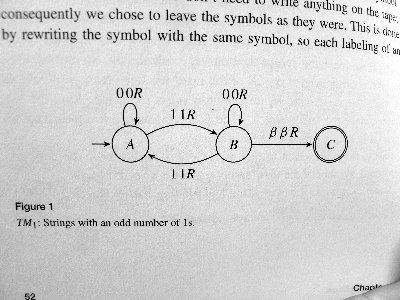
from Turing's Vision… Chris Bernhardt (make note of encoding scheme)
"We will suppose that the computer works in such a dissolutory manner that he never does more than one step at a sitting." [altered Turing: ON COMPUTABLE NUMBERS, WITH AN APPLICATION TO THE ENTSCHEIDUNGSPROBLEM - https://www.cs.virginia.edu/~robins/Turing_Paper_1936.pdf ]
http://files.flageorgia.org/hkurz/wiener/ow-1-us.htm (see also Wiener: Form and Content in Thinking Turing Machines in The Universal turing machine : a half-century survey / Rolf Herken (ed.))
Collect some more Wiener here!
3.3.1 How we encode the TM tape/TM description?
- light and dark, sunrise and sunset, acidic or alkaline/base…
- what about BLANK - or we just have 2 states:
two letters and two states: http://www.complex-systems.com/pdf/19-1-2.pdf
3.3.2 hardware
http://aturingmachine.com/hardware.php
https://github.com/mit-ll/TuringMachine - in this case how takeup/tensioning works with one motor winding tape back and forth and other two opposoing take up using potentiometers on each side
3.3.3 software
3.3.4 compilers
Turing Machine Compiler Collection: https://sourceforge.net/projects/tmcc/
C to brainfuck compiler: http://esolangs.org/wiki/C2BF
3.4 Practical notes for our Turing machine dripper…
3.4.1 Encoder thing for end of run =
purple -> GND
orange -> sense pin 7 with pullup
brown -> 400ohm to +5V
- gives a 1 when we hit that end
3.4.2 Stepper (3v)
Grey, blue, red, yellow… unipolar pjjq114za-k
TODO: use other stepper board!
accelstepper or just default arduino stepper:
#include <Stepper.h>
const int stepsPerRevolution = 200; // change this to fit the number of steps per revolution
// for your motor
// initialize the stepper library on pins 8 through 11:
Stepper myStepper(stepsPerRevolution,5,6);
int stepCount = 0; // number of steps the motor has taken
#define E1 4
#define M1 5
#define E2 7
#define M2 6
void setup() {
// initialize the serial port:
Serial.begin(9600);
pinMode(E1,OUTPUT);
digitalWrite(E1,HIGH);
pinMode(E2,OUTPUT);
digitalWrite(E2,HIGH);
}
void loop() {
// step one step:
myStepper.step(1);
Serial.print("steps:");
Serial.println(stepCount);
stepCount++;
delay(500);
}
See below/end for further software notes!!
3.5 A geomantic processor/software
See also: https://digitalambler.wordpress.com/2016/02/29/divination-methods-and-programming-languages/
We will use pyephem for constellations above and around the gallery - what is its precise location and what direction is it facing?
Pyephem driven Turing Machine -> planets as tape, stars or satellites as description…
3.5.1 examples/ref
4 semiconductor
https://groups.yahoo.com/neo/groups/home_transistor/search/messages?query=%22thin%20film%22

Compared to Mutus Liber Plates 10/13:

4.1 Amateur Scientist - DIY FET/home-made transistor Scientific American June 1970 (Baker) as most useful resource:
http://1010.co.uk/materials.html



Questions here:
"A great variety of semiconducting oxide films can be made by thermally decomposing the resinate salts of metals. Resinate salts are prepared by stirring an excess of pure granulated resin into a one-normal (1 N) solution of sodium hydroxide. The solution turns milky as it cools. Pour off and retain the milky solution. To make a metal resinate, reheat the milky sodium-resinate solution and combine it with a weak solution of the metal salt, stirring the mixture vigorously."
"A relatively large volume of sodium resinate reacts with a small volume of metal salt. An excess of sodium is indicated by a pH of 8 or more. Add metal salt to lower the pH. The desired metal resinate appears as a thick precipitate.
"Filter the solution to recover the precipitate and wash it thoroughly with hot distilled water. Spread the moist filter cake and dry it at a temperature of about 50 degrees C. Dissolve the dried material in an organic solvent such as turpentine. Allow the sediment to settle. Use the clear upper layer for experiments.
"With a disposable capillary tube apply a few drops of the clear fluid to the center of a prepared cover glass and rock the glass to spread the fluid into a uniform film that extends to the edges. Heat the coated glass on the hot plate. The film will smoke and turn dark. In time, at a temperature that depends on the nature of the resinate, the dark color will clear, leaving a thin film of metallic oxide."
So:
1] weak solution of metal salt (acid?)
2] dissolve granulated rosin in sodium hydroxide/lye/caustic soda
3] as above with filters and turpentine
- What is the "pure granulated resin"? (note sodium hydroxide/ NaOH is lye or caustic soda)
- This results on heating in oxide films so what are the metal salts? Sulfides? (as they are in solution?)
A salt is formed by the replacement of the hydrogen ion of an acid by a basic radical. For instance, when a metal (eg. Cu) reacts with a mineral acid like HCl or H2SO4, you get the salt of that metal (CuCl2 or CuSO4). Generally, salts have a metal cation and either an anion which used to be a part of a mineral acid. These are ionic compounds and are easily soluble in water.
- Why is the example of cadmium sulfide for a FET so different?
deposition?
See also: https://www.google.ch/patents/US7947537
Ancient deposition: http://liu.diva-portal.org/smash/get/diva2:785164/FULLTEXT01.pdf
//
References: THIN FILM MICROELECTRONICS: THE PREPARATION AND PROPERTIES OF COMPONENTS AND CIRCUIT ARRAYS. Edited by L. Holland. John Wiley & Sons Inc., 1965.
Equipment: hotplateX, [diamond cutter(optional)], [atomizer], 35mm glass slides, filters
Materials: vinyl cement, silicone, silver paste, indium for electrodesX, nitric acid, distilled waterX, sulfurX
and using:
resinate salts of metals IN sodium hydroxide, turpentine. So for cadmium chloride/sulfide: thiourea, ammonium hydroxide, hydrochloric to clean.
What would we need to work with other metal salts such as antimony trisulfide?
4.2 zinc oxide:
4.3 refs/links/collections:
https://www.quora.com/How-do-I-make-my-own-diodes-and-transistors-at-home
http://hackaday.com/2010/05/13/transistor-fabrication-so-simple-a-child-can-do-it/
http://www.teralab.co.uk/Experiments/Selenium_Photocell/Selenium_Photocell_Page1.htm
http://www.google.com/patents/US4331707
Instruments of Amplification, Book of the Transistor, Quick assays in mineral identification in: http://xxn.org.uk/The_Crystal_World_Reader_v.1.pdf
4.4 materials - silicon and antimony
Find ref. antimony in semiconductor/thin film deposition
crystal<->crystal detector is silicon-antimony junction
antimony is N-type dopant of silicon
salts - antimony dry way?
4.5 notes
computer fan for spin coating?
4.6 how we can test:
4.6.1 crystal radio
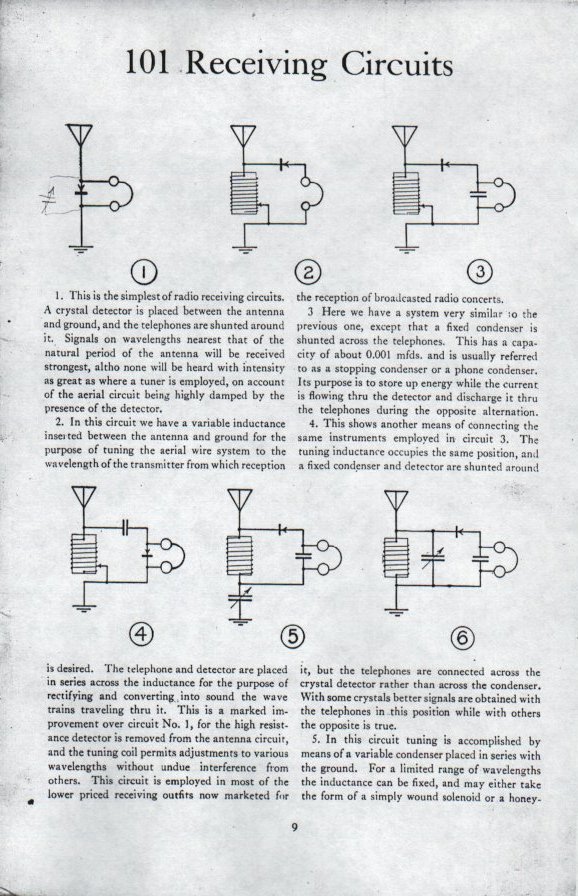
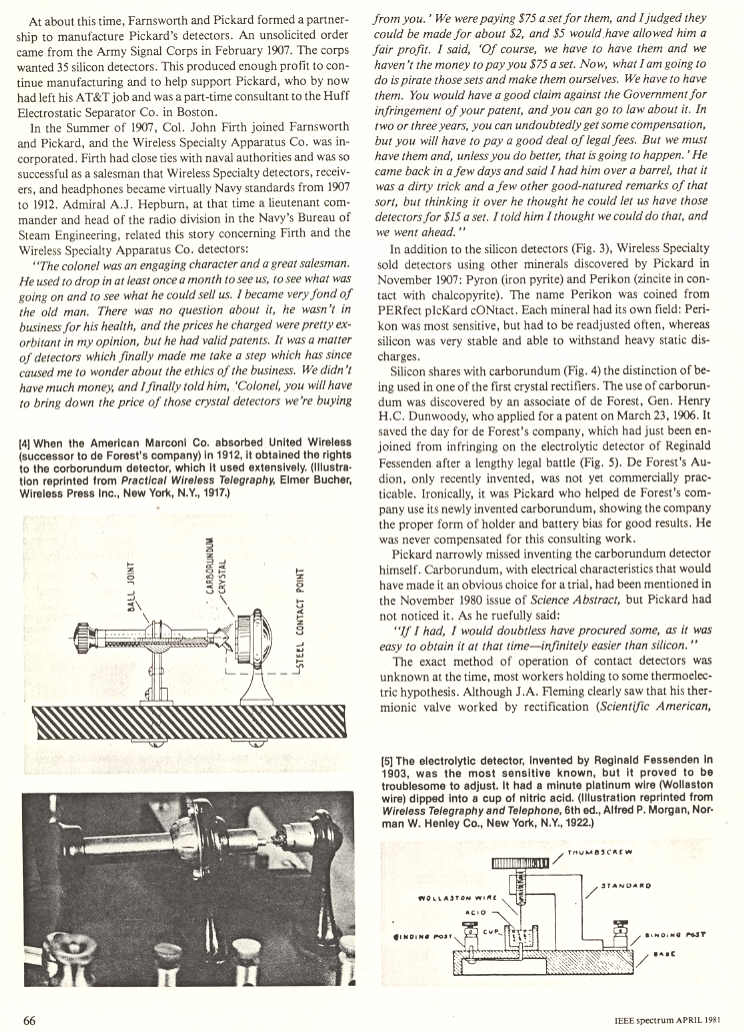
List of minerals: http://www.crystalradio.net/minerals/index.shtml
Another list: http://www.hpfriedrichs.com/radioroom/crystals/doc/crystals-of-crystal-radio-table1-2014-06-11.pdf with notes: http://www.hpfriedrichs.com/radioroom/crystals/rr-crystals.htm
http://crystalreceiver.co.uk/projects.htm
http://sci-toys.com/scitoys/scitoys/radio/homemade_radio.html
http://n4trb.com/AmateurRadio/SemiconductorHistory/SemiconductorDocuments.htm
4.6.2 curve tracing
What we need is just for simple semiconductor junction -V to +V… so dual supply into arduino…
All single supply: https://www.elprocus.com/arduino-project-on-transistor-curve-tracer/
http://www.instructables.com/id/Arduino-BiCMOS-Curve-Tracer/
http://ioblocks.blogspot.ca/2014/05/build-simple-transistor-curve-tracer.html
hmm http://www.forembed.com/project-curve-tracer-schematic-creation.html
4.6.3 photocell with salt water?
5 dissolution
5.1 heat
5.2 acids
- nitric from saltpeter or air (also ammonia)
- hydrochloric from sea salt (distillation high heat) or salt and sulphuric acid (from VITRIOL)
or sulphuric acid from pyrite weathering (AMD-Acid Mine Drainage): http://www.ei.lehigh.edu/envirosci/enviroissue/amd/links/science2.html
5.3 circular/ouroboric
- motherboard provides air flow and higher voltage arc to produce nitric acid to dissolve itself
- Th. Ferri eats a semiconductor junction [of antimony/iron/silicon] - or other bacteria?
5.4 and sublimation
[of iodine, of napthalene, of sulphur under high heat, of ammonium chloride/sal ammoniac/ but this is not strictly sublimation in modern chemical sense]
Linden p.18
http://www.levity.com/alchemy/ripgat8.html THE EIGHTH GATE - SUBLIMATION
Ripley - To make the body spiritual, to make the spirit corporeal and "consubstantial" and "fixed" with the body; and to cleanse the "filthie originall"
And Sublimations we make for three causes,
The first cause is, to make the body spiritual,
The second is, that the spirit may be corporeal ,
And become fixed with it and consubstantial,
The third cause is, that from its filthy original
It may be cleansed, and its saltiness sulphurious,
May be diminished in it, which is infectious.
6 materials notes
silver nitrate - collodion process
gold chloride in solution reduced to gold by adding copperas (ferrous sulphate): https://www.ishor.com/large-scale-gold-refining-using-aqua-regia#mixing_aqua_regia
aqua regia - nitric acid and sea salt (nitric and hydrochloric)
6.1 mineral identification and testing
For identification of minerals: https://physicalgeology.pressbooks.com/chapter/5-6-mineral-properties/
6.2 Gamma spectrometry
- quick start with Theremino - gamma spectrometry
rmmod snd_hda_intel
pulseaudio
set up with alsamixer
wine Downloads/Theremino_MCA/Theremino_MCA.exe
Then: noise test first of all for zero trim?
Trimmer inside theremino box - lower resistance = higher voltage/// so higher res = lower = CCW away from GND
so for 700v we set trimmer to far left CCW (we have 750-1500 model)- lowest voltage
also gain trimmer on scintillator itself!???? - on ludlum is under screw/bolt..
see: https://siliconpr0n.org/wiki/doku.php?id=st-gobain:1600-2265
- voltage should be 800 to 950v (650?) for square tube - bicron
LUDLUM 44.21 is 400-1200V
FWHM width percentage is in QUESTION!
- weathering of iron and other pyrites:
From: http://www.juliantrubin.com/encyclopedia/chemistry/copperas.html
Copperas is crude ferrous sulfate, and was formerly known as green copperas to distinguish it from white copperas - zinc sulfate, blue copperas and copper sulfate.
Making copperas was a vast industry here in Britain from the 1600's till the late 1800's. It was sited along those areas of the coast - Kent, Essex, the Thames estuary and elsewhere, where there are still abundant supplies of pyrites (or more probably, marcasite) from the Lias and other clays of the costal cliffs. It is not the golden nuggets of mineral collectors and museums, but rather, a dull black pebble, which is remarkably heavier than other pebbles as it contains a lot of iron. Only when smashed with a hammer does its true nature become evident - the grey-green metallic lustre of the fresh surface, and a slight smell of sulfur.
From copperas you can make ink, sulfuric acid, hydrochloric and nitric acids, aqua regia, jeweller's rouge, and Venetian Red, and thus it formed the basis of the earliest chemical industry.
The process for making copperas is the weathering of iron pyrites, as practiced in Nordhausen in Germany as the first stage in the process for making the famous Nordhausen sulfuric acid. The same process was practiced along the Thames estuary, probably brought to England by Flemish settlers. On an industrial scale, large pits, the size of tennis courts, and about fifteen feet deep were lined with timber. A channel at the bottom allowed liquors to run into a cistern. These pits were partly filled with the abundant local pyrites, and simply left in the sun, wind and rain to weather for two or three years. From time to time the liquors were run into the cistern, then boiled down. The concentrated solution would deposit on cooling, green crystals of copperas - ferrous sulfate - FeSO4.7H2O. A greater yield could be obtained by adding scrap iron to the hot solution. The crystals were often gathered on twigs, where they formed like barley sugar. Because big crystals look like green glass, it is also known as green vitriol. Roasting this gives off white fumes of sulfur trioxide, which can be condensed to strong sulfuric acid. This is a heavy oil-like liquid, hence its old name of Oil of Vitriol. But it's not an oil, for it doesn't float on water. Instead it mixes with water vigorously releasing a lot of heat.
My home process consists of putting a layer of iron pyrites nodules into the bottom of a plastic bucket, just covering with RAIN water, and allowing the contents to stand and evaporate in a warm room - or outdoors in the summer heat, for several weeks. My first attempt didn't work quickly - all I got after several weeks was a pale rusty solution, which was slightly acidic, and tasted metallic. I don't know if this is due to an inherent time lag before the process gets started, or else because I'd used chlorinated tap water, or else had put in too much water. In disgust, I transferred my experiment from the attic to my back yard over the summer. Some weeks later I peered inside. To my surprise and delight, the black nodules were all covered with a white and green encrustation - I'd made copperas - accidentally! Since then I've made a lot, from the same nodules. The process depends on the decomposition of pyrite - FeS2, not by atmospheric oxygen as it states in old chemistry books, but by bacteria - Thiobacillus Ferrioxidans and similar. These extremeophile organisms eat pyrites depositing ferrous sulfate as a waste product. The organisms have been living inside the nodules in a latent state for thousands or perhaps millions of years, and presumably need warmth, air and fresh water to waken up from their dormant state.
Though I've used pyrites nodules I gathered myself from Lias clays near Lyme Regis, which are black on the outside, I suspect the process will work with any form of pyrites. My golden nuggets which mostly come from South America are too expensive to ruin in such an experiment, but probably would work just as well. Pyrites is a very common mineral - the gold streaks found in coal are made of it ("coal brasses") and most metalliferous mine tips will provide adequate supplies - look for the rocks which are particularly rusty. Any geologist will be glad to point out local sources, and usually provide you with free samples. Pyrites, the plural, is the name used by chemists, geologists nowadays tend to use the singular, pyrite.
The encrustation on the pebbles is a layer of beautiful white needles up to 5 mm long. Underneath is a moist layer of pale green ferrous sulfate - looking like grains of green sugar. When the mixture dries out completely, the pale green crystals turn white - presumably due to loss of water of crystallization. I don't know the chemical composition of the outer layer of white needles - it may be simply a different crystal form, or a different hydrate, or perhaps a different oxidation state.
Once the pebbles have become active, a fresh layer of copperas will appear within two or three days of removing the original crust - you don't have to wait weeks as I had to do at the start. It is important that the nodules are left poking out of the rain water into the air. Exposure to daylight doesn't seem to matter, but rain water seems to be preferable to tap water.
I haven't tried to get oil of vitriol from my crystals yet, but I have used them to make black ink. Simply add a solution to cold tea - and Hey, Presto ! The dense black can be rendered colourless by adding oxalic acid to the liquid. The black solution was the only black dye permitted by law for dyeing silk in Britain for several centuries. It was the only black ink used from ancient times which was not based on soot. Cold tea contains tannin - as does an extract of oak or other barks, oak galls, pomegranates and many other vegetable sources. Tannin produces a black pigment with iron. Try hammering a nail partly into a piece of oak and leave out in the rain for several weeks. You will get a black streak, not a rusty one as you would expect.
Roasting the copperas will leave a rusty residue of iron oxides, known as Jeweller’s Rouge or Venetian Red, depending on the hue and the method of preparation. This can be used for polishing glass and gold, or as a pigment.
Roasting the copperas with potassium nitrate should yield brown fumes of nitric acid.
See also: http://www.southampton.ac.uk/~imw/Brownsea-Island-Geology.htm#LOCATION-Southeast-Cliffs
- glass of antimony:
Valentine's The Triumphal chariot: Making Glass of Antimony (p.44 The Alchemical Tradition, Grossinger) (see also Last Will: https://archive.org/details/lastvvilltestame00basi )
[GLASS OF ANTIMONY WITH BORAX]
For there are other Glasses prepared of Antimony, by Addition of Borax and other things, in this manner.
Take of Crude Antimony one part, of Venetian Borax two parts; put these together into a Crucible, which setting the Vessel in a Wind-Furnace, or urging the Fire with Bellows, cause to flow, that they may be well and perfectly mixed together, afterward pour out the Mixture into a Pan, or Dish of Copper made hot, as thin as is possible, as before was said in the Superior Preparation, and you will find you Antimony fair and transparently clear, *like a Pyropus or Ruby, provided you observe the due and accurate Method, Operating as you ought, in the Governing Fire.
*The Caution, to which our Author here ascribeds the Success, is that you use a most strong Fire, such as is required for melting Gold: for without this you cannot acquire the Redness of a Pyropus.
The Redness may be abstracted from this Red Glass, with Spirit of Wine*, and by long continued Circulation in Fire, be perfected, and rendered a most excellent, profitable and efficacious Medicine.
*Not with common Spirit of Wine, but with Philosophic Spirit, which for extracting this Tincture, I thus prepare. Take of Sal-Armoniac thrice sublimed four ounces Spirit of Wine, distilled upon Salt of Tartar so, as it may be perfectly dephlegmated: put them together in a Phial, which place in heat of Digestion the Spirit may fully imbibe Sulphur or Fire of the Sal- Armoniac; then distil the mixture by Alembic thrice, and you will have a true Menstruum, wherewith to Extract that Redness from the Glass of Antimony. Also the Tincture of this Glass is extracted with its proper Vinegar, and by a further Operation is perfected, and becomes a most excellent Medicament.
But a transparent white Glass of Antimony, after commixtion thereof, is prepared in this manner.
[ANOTHER GLASS OF ANTIMONY WITH BORAX] Take Antimony beat or ground small one part, Venetian Borax very pure four parts: put these, well mixed together, into a Crucible, and cause the Mixture to flow well. At first indeed it will be yellow, but if it stand longer in Fire, the yellowness vanisheth, the Matter receives a white Colour, and thenceforth becomes a fair and white Glass. Whether this colour be brought to perfect Maturity, you may prove with a cold Iron, as above is said. Many other ways, of Antimony may be formed Glasses* consisting almost of infinite Forms.
*Let him who desires to prepare more Glasses of Antimony, consult Beguinus, Hartman, Crollius, and other Authors; we here acquiesce in these proposed by Basilius.
From: http://www.sacred-texts.com/alc/antimony.htm
http://www.alchemylab.com/triumphal_chariot.htm
Bartlett says that the use of borax is an error/misleading … p.198
Lawrence Principe reconstruction: https://www.youtube.com/watch?v=2vS4aPQI80M
(note: He mentions quartz as part of impure stibnite, silicon! - stibnite is antimony trisulfide (Sb2S3) -> link to semiconductor junction of antimony and silicon above?)
- Principe on stibnite/glass of antimomy - from The Secrets of Alchemy:
Stibnite–roast (-sulphureous fumes)–>Ash–fuse–> Glass of Antimony –extract with vinegar (-inert dregs)–>Red Extract–extract with alcohol (-poisons)–>Sulphur of Antimony
A schematic of Valentine's chemical transformation of poisonous antimony into medicine. At each step, toxic or inactive materials are suposedly separated - an ilustration of the Paracelsian principle of Scheidung.
The most famous book in the Valentine corpus appeared in 1604 under the grand title of "The Triumphal Chariot of Antimony (Der Triumph-Wagen Antimonii)". [..] Valentine first describes a way to isolate the Sulfur of antimony. He begins by making "glass of antimony" (vitrum antimonii) - a vitreous substance used commonly (and perilously) to induce vomiting. He extracts the glass with vinegar to provide a red liquid, evaporates the liquid to a gummy residue, the extracts the residue with spirit of wine (alcohol) to give a sweet red oil. This oil is suposedly the Sulfur of antimony, and is no longer emetic or purgative because all poisonous qualities have been separated.
[…]Making the glass of antimony seemed a trivial preparation: this material appears commonly in early modern pharmacopoeia. Valentine even apologizes for starting with something so easy, but the initial results of replicating his procedure showed that the apology was unnecessary. Valentine instructs the reader to grind antimony ore (stibnite, native antimony sulfide), roast it slowly until it turns light gray, melt this "ash" in a crucible, and the pour out the molten material to provide "a beautiful, yellow, transparent glass". Accordingly, I took antimony sulfide and roasted it (laboriously, since it takes two or three hours of gentle heating and constant stirring, a process known as calcination) to a light gray "ash". This ash - predominantly antimony oxides - melted only with great difficulty, and when poured out solidified to a dirty gray lump. Many repeated attempts, with modifications to the temperature and duration of roasting and the length of time the ash was kept molten, always gave the same miserable result. After having exhausted other ideas, I obtained a sample of ore from Eastern Europe (Valentine specifies the use of "Hungarian antimony"), ground it, roasted it, fused the ash, all exactly as before - and this time obtained the beautiful, yellow, transparent glass.
What finally went right ? Analysis of the ore showed that it contained a small amount of quartz, one of the most common minerals on earth. This minute quantity, about 1 or 2 percent of the ore's total weight, proved to be the key; without its presence, the glass does not form. In fact, when i took the ugly gray lumps from the failed trials, remelted them, and added a pinch of powdered quartz (or silica, silicon dioxide), they also turned into beautiful golden glasses.
[…] Valentine next tells readers to powder the glass and extract it with vinegar to produce a red solution. Once again, the process failed. The yellow glass made with the addition of quartz gave no color to vinegar, even after weeks of stirring. The glass made from the ore gave only a pale reddish color after several days. Chemical analysis provided a surprise: this redness was due not to any antimony compound but rather to iron acetate, undoubtedly from trace amounts of iron in the ore. This red material was formed in such a small quantity that it seemed impossible for Valentine to have made as much of it as he claimed. This time the key lay in a disregarded detail in his recipe: Valentine writes that he stirred the roasting ore with an iron hook, and the stirred the molten glass with an iron rod. Antimony compounds corrode iron very quickly. Thus, Valentine's iron tools enriched his glass with iron compounds. They provided the very substance he was isolating as the "Sulfur of antimony". Valentine's Sulfur of antimony actually contains no antimony whatsoever; it was extracted not from the antimony but rather from his laboratory ustensils!
This amusing conclusion explains Valentine's claims and observations perfectly. Vinegar dissolves the iron out of the glass, but also dissolves some antimony compounds - hence, the vinegar extract still has the purgative properties Valentine noted. But after the vinegar solution is evaporated, and the gummy residue is extracted with spirit of wine, only the iron acetate disolves, leaving all the antimony behind in insoluble residues. As Valentine writes (correctly), "the residue that remains behind contains the poison, the extraction takes up only the medicine". The alcohol extract is completely nontoxic, and is, just as Valentine says, "sweet", for iron acetate has a slightly saccharine taste.
- star regulus
Antimony metal can be made to form a visibly crystalline structure by slowly cooling the molten antimony beneath a thick layer of slag. The antimony is reduced from stibnite (Sb2S3) by heating it with iron and saltpeter until fusion ensues. The antimony initially reduced must be further purified by repeated fusion with additional saltpeter before the star can be produced.
- Lister/antimony
From Web of Nature: Martin Lister (1639-1712), the First Arachnologist, Anna Marie Roos
[ also in: http://rsnr.royalsocietypublishing.org/content/64/2/105 ]
Interesting as:
In 1674 the natural philosopher and physician Martin Lister published a new method of making glass of antimony for telescopic mirrors, using Derbyshire cawk or barite as a flux. New manuscript evidence reveals that Sir Isaac Newton requested samples of the cawk and antimony from Lister…
Glass or vitrum of antimony was traditionally created by using what Lister referred to as ‘crude antimony’ or stibnite (Sb2S3, antimony trisulphide) which was ground and then slowly calcined at high heat. The remaining antinomy calx or oxide was then vitrified in a wind furnace, and it was poured into a wide flat dish of metal, generally copper or brass, where it quickly cooled, resulting in the ‘glass’. A wide flat dish of brass or copper with high heat conductivity ensured rapid cooling, the retention of the unchanged sulphide hindering the crystallization of the pure oxide sufficiently to allow glass formation; Rawson has noted that antimony trioxide is considered difficult to obtain in the glassy phase other than through rapid quenching or cooling.26 Principe has described the chymical process that Basil Valentine used in modern chemical terms, noting: ‘when antimony trisulphide is roasted slowly in the air, the oxides of antimony are formed and sulphur dioxide is released’. Antimony oxides, together with residual trisulphide, compose a white ash, which on heating to fusion should produce a yellow or golden transparent glass of antimony.

However, if the stibnite is too purified, no glass will form, and later chemists such as Caspar Neumann (1683–1737), a chymist from Berlin and follower of Georg Stahl, and J. W. Mellor (1869–1938), author of A comprehensive treatise on theoretical and inorganic chemistry (1922), recommended adding sulphur, antimony sulphide or antimony trisulphide to the ash to make vitrification occur.28 Although these chemists thought that by adding sulphur they were making the alchemists' glass of antimony, Principe has found that they were mistaken; their product was a deep red or violet glass, rather than the golden one of Basil Valentine's.29 The addition of silica to the ash does, however, cause the reaction that Valentine described to occur. Valentine was probably using unrefined stibnite that contained silica, and the alchemist's crucible would probably have had an ‘easily-dissolvable silica based glaze’, so an impurity that was not mentioned in Valentine's original account was necessary for the formation of the glass.30 Whether a red vitrium or a golden glass of antimony was created, the poisonous antimony powder, noxious sulphurous fumes and long heating process made these reactions dangerous and tedious.
Lister's method using cawk stone seemed to solve some of these problems. He stated, ‘the several vitrifications of Antinomy are either opaque or transparent. To the first kind I shall add one, which is in itself very curious, and that these advantages about the rest, that it is done with great ease and Speed.’31 He fluxed antimony ‘clear’, and while that occurred, heated to red heat ‘an ounce or two of Cawk-stone’ that had been gathered in Derbyshire lead mines, and placed it in the crucible with the antimony, continuing the flux for a few minutes.32 The product was then cast into a clean mortar, and the melted liquor was decanted from the cawk, resulting in a substance ‘like polish'd steel’ and as ‘bright as the most refined quicksilver’.33 Lister then noted that the cawk itself did not incorporate with the antimony, so it served purely as a flux. He concluded by stating that he had reacted a variety of substances with antimony, such as lapis calaminaris (calamine or zinc carbonate), stone sulphur (native sulphur), galactites (natrolite, a milky white semiprecious stone), marcasites, alum and ‘divers sparrs’ but none of these minerals had ‘any such effect on Antimony’.34 Lister then promised ‘another time’ to discuss the spirit of the cawk that resulted from distillation, but he never did manage to publish any more about the topic, perhaps wanting to keep all details about it to himself.
From his brief account and his chymical manuscripts, we can deduce from the literature what was happening chemically (I am currently engaged in reproducing Lister's experiment in the laboratory so that I shall subsequently be an actual witness rather than a virtual witness of the procedure). Lister's description of the cawk-stone, which he termed a ‘very odd mineral’, as ponderous, white, with a smooth shining grain, is of barite (barium sulphate), otherwise termed by the miners ‘heavy spar’.35 In his unpublished manuscript dedicated to minerals or ‘fossils’ in northern England, Lister recorded a series of experiments with the cawk, noting that it was ‘very full of Sulphur’, so much so that when he calcined it in his home laboratory in York it ‘smelt soe strongly sulphureous, yt ye fume of ye Furnace infected all ye neighbourhood’.36 He noted that a lixivium of the cawk also tinged silver yellow, indicating its sulphurous content.37 In his Medicinal Experiments, Robert Boyle mentioned a ‘Tegument’ of the Veins of Lead, ‘which the Diggers name Cawk, which is white and opacous’, so the term was a commonly known one; later mineral guides clearly identify Derbyshire cawk as barite.38
When barium sulphate was added to the antimony and the mixture was heated in the furnace, the resultant melt would contain primarily antimony sulphide. Just as in Valentine's case of impure stibnite promoting vitrification, Lister's more complex melt would more easily form a stable glass, and lead oxide impurities in the barium sulphate that originated from lead mines would also be a definite help in this regard.39 Heaton and Moore (1957) observed that the glass of antimony was more stable in the presence of lead oxide.40 As in Principe's description of Valentine's crucibles, the crucibles that Lister used in his work would probably be either fire-clay or sillimanite, and during melting the pot would be likely to suffer attack. Alumina would find its way into the melt by dissolution of the pot material, and again this would help to stabilize the glass and make the production of the glass easier.41
- Vinegars, oils, wet way with antimony
Via humida - Bartlett p. 217
and how this might square with semiconductor production/thin films?
- identifying antimony ore/stibnite
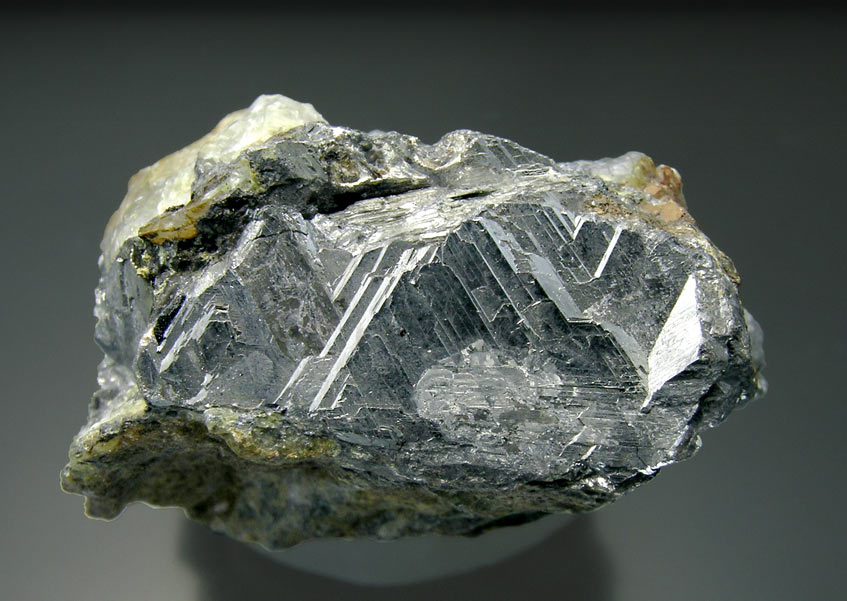
Stibnite is the commonest and the most important ore of antimony. As found, however, it usually contains small quantities of iron and often traces of silver and gold. Surfaces that are exposed to the air are often coated with a black or an iridescent tarnish. It is a nonconductor of electricity.
Identification and Diagnostics Stibnite is characterized by its bladed structure, perfect cleavage in one direction, its lead-gray color and soft black streak. It fuses very easily, thin splinters being melted even in the flame of a candle. When heated on charcoal the mineral yields antimony and sulfurous fumes, the former of which coat the charcoal white in the vicinity of the assay. Stibnite may easily be distinguished from all minerals but the other sulfides by the test for sulfur. From the other sulfides it is distinguished by its cleavage and the fumes it yields when heated on charcoal. Its closest resemblance is with galena, which, however, differs from it in being less fusible and in yielding a lead globule when fused with sodium carbonate on charcoal. Moreover, galena possesses a cubic cleavage.
- streak: blackish gray (unglazed porcelain tile)
- hardness: 2-3
- luster: metallic
- non-magnetic
[but ours does not fuse in (admittedly) small candle flame - and Faraday writes that it will not fuse so…]
http://www.webmineral.com/data/Stibnite.shtml#.V_47oEc-I50
http://www.galleries.com/antimony
What could it be confused with?
- arsenic and arsenopyrites:
http://www.minerals.net/mineral/arsenopyrite.aspx
Grayish/black streak and looks very similar but arsenopyrites:
- Gives off a garlic odor when struck or heated.
- Dissolves in nitric acid (doesn't antimony?)
check also for closeness of any GOLD!
- antimony and sky/stars
http://www.thirax.dk/artikler/OveSpaeth/Ove27/index-uk.htm
also raven constellation
how we can begin with material/geomantic processor in this sense…
- notes
Principe - Starkey works
antimony and pH measurement: http://corrosion-doctors.org/Corrosion-Thermodynamics/Measuring-pH-antimony.htm
further DIY pH: https://noisebridge.net/wiki/BioBoard/Documentation/pH
GeSbTe (germanium-antimony-tellurium or GST) in DVD-Rs:
https://en.wikipedia.org/wiki/GeSbTe
http://www.osta.org/technology/dvdqa/dvdqa13.htm
related… https://www.hindawi.com/journals/ijp/2013/154694/cta/
- references
Isaac Newton: http://www.levity.com/alchemy/markh_1.html
Glass: https://mariekehendriksen.nl/2014/11/26/strange-glass-vitrium-antimonii/
References to antimony in: https://monoskop.org/images/9/98/Elkins_James_What_Painting_Is_2000.pdf
6.2.1 Streak test notes/examples
Insights in Earth Science: A Laboratory Manual for Physical and Historical
By Clair Russell Ossian
6.2.2 copperas - V.I.T.R.I.O.L (also in field trip document)
Iron (II) sulfate
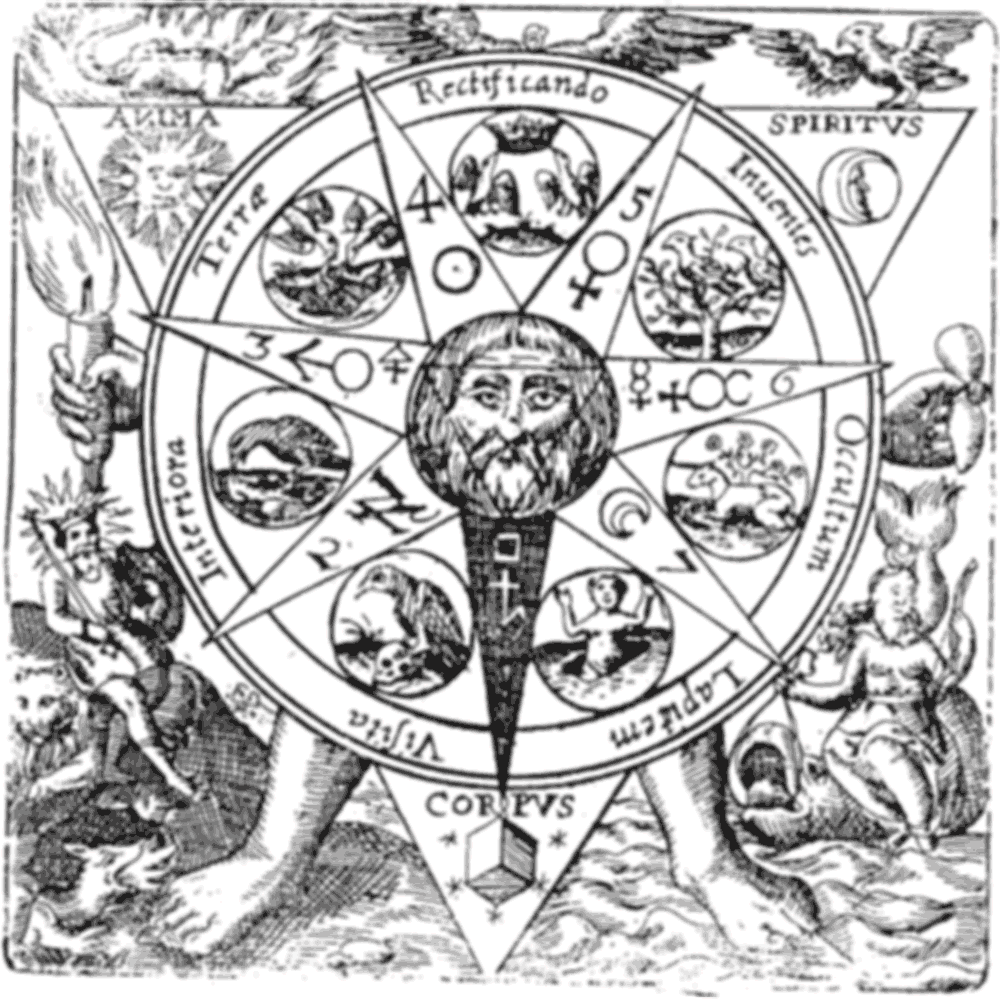
Visita Interiora Terrae Rectificando Invenies Occultum Lapidem," which means "Visit the interior of the earth, and by rectifying (correcting or purifying) what you find there, you will discover the hidden stone.
copperas/ferrous sulfate/green vitriol
What is hungarian vitriol? mars and venus (copper and iron)
Copper-iron sulfide is chalcopyrites
Green vitriol is also a useful reagent in the identification of mushrooms:
Iron salts are used commonly in Russula and Bolete identification. It is best to dissolve the salts in water (typically a 10% solution) and then apply to the flesh, but it is sometimes possible to apply the dry salts directly to see a color change. For example, the white flesh of Boletus chrysenteron stains lemon-yellow or olive. Three results are expected with the iron salts tests: no change indicates a negative reaction; a color change to olive, green or blackish green; or a color change to reddish-pink.
6.2.3 antimony = Sb

According to Leiden professor of medicine, chemistry and botany Herman Boerhaave (1668-1737), the symbol for antimony:Antimony symbol “Denotes a chaos, χάος, world, or one thing which includes all: this is the character of antimony; wherein is found gold [the circle symbol], with plenty of an arsenical corrosive [the cross at the top].” [https://mariekehendriksen.nl/2014/11/26/strange-glass-vitrium-antimonii/]
purification from stibnite - p.196 Way of the Crucible
Oil but references glass: http://www.tpissarro.com/alquimia/antimoil-e.htm
http://homepages.ihug.com.au/~panopus/lab/antimony.html
star regulus of antimony: with iron filings and flux (burnt tartar)
how antimony works with gold? - it eats/consumes the king/sol/gold - it is the green lion (see Newton below)
fused antimony (saltpeter and detonation also)
7 equipment/apparatus notes
The vessel (i.e. the athanor/furnace/fire) and the matter are one.
Sealed, digesting, invisible and funereal - furnace, vessel, matter.
7.1 furnaces

7.2 culturing ferro-oxidans
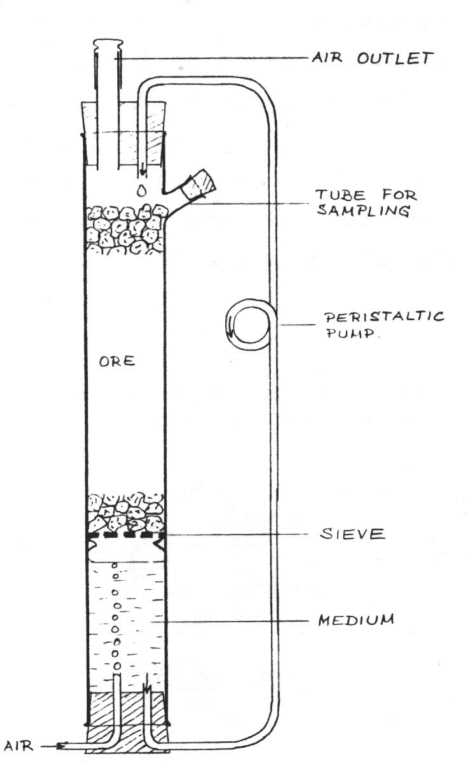
Pump: http://www.instructables.com/id/Inexpensive-easy-to-build-peristaltic-pump/
Acidithiobacillus (Th.) ferro-oxidans
See also: https://www.911metallurgist.com/cyanidation/thiobacillus-ferrooxidans/
https://astrobiology.nasa.gov/news/living-on-fools-gold/
Leaching: http://www.spaceship-earth.de/REM/Naeveke.htm
Microbial leaching of ores depends primarily on bacterial processes which are the essential causes of natural weathering of sulfidic minerals. If sulfidic heavy metal minerals come into contact with air and water they begin to decay with the formation of sulfate, sometimes sulfuric acid, and water soluble heavy metal cations.
iron pyrite = iron (di-)sulfide/FeS2 -> copperas = iron sulphate FeS04.H2O

Pyrite has been used since classical times to manufacture copperas, that is, iron(II) sulfate. Iron pyrite was heaped up and allowed to weather (an example of an early form of heap leaching). The acidic runoff from the heap was then boiled with iron to produce iron sulfate. In the 15th century, such leaching began to replace the burning of sulfur as a source of sulfuric acid. By the 19th century, it had become the dominant method.
http://www.ncbi.nlm.nih.gov/pmc/articles/PMC184846/
Arsenic, molybdenum, silver and mercury may be toxic to Thiobacilli. Noteworthy is the higher tolerance against molybdenum of Sulfolobus brierleyi: this bacterium metabolizes without inhibition at a molybdenum concentration of 20 mmol/l or higher, whereas Thiobacilli tolerate molybdenum only up to about 1 mmol/l (Brierley, Murr, 1973). In some cases the tolerance of leaching bacteria against toxic substances may be developed by adaptation.
7.3 vessels


[images - own/alchemical]
http://www.levity.com/alchemy/apparat2.html
http://www.alchemywebsite.com/images_apparatus.html
http://antiquity.ac.uk/projgall/martinon/
- micro-macro - small incubators/digesters of same size as heatsinks more or less…
- ceramic or glass
if ceramic could include materials such as earth, copper, gold, antimony, sulfides/oxides in glaze and/or materials
silica: https://digitalfire.com/4sight/oxide/sio2.html Si02 not Si silicon
glass - spun, blown from silicon wafers?
- vessels are sealed after filling/insertion by heating and twisting glass end (or with wet clay and then dried in case of ceramics?)
7.4 equipment/ to get / build
- dehumidier - air-> water extraction
- Apple II as control/dissolution
- various fans/motherboards/heatsinks to collect and experiment with // software->heat side also
- nitric from air: https://www.youtube.com/watch?v=smKX36mvBiQ Birkeland Eyde…
8 fieldtrips

- reader for fieldtrip: http://1010.co.uk/dissolution_fieldtrip_techniques.pdf
8.1 locations
Stibnite:

Lapa: http://www.mindat.org/loc-257070.html // working so not visited
Sigma: http://www.mindat.org/loc-22946.html // working so not visited
Lac Nicolet (not in same area as above): http://www.mindat.org/loc-618.html
Also see: http://www.yoho-lake.com/pdfs/NRCan%20-%20Antimony.pdf
and: http://www.goldstarminerals.com/en/properties/new-brunswick
Pyrites:
http://www.sandatlas.org/pyrite/
As above (and more!)
8.2 collection and sampling
gold, copper, iron, stibnite, pyrites of iron/copper
8.3 copper smelting
copper ores: chalcopyrites (copper iron sulfide):

malachite (copper carbonate):
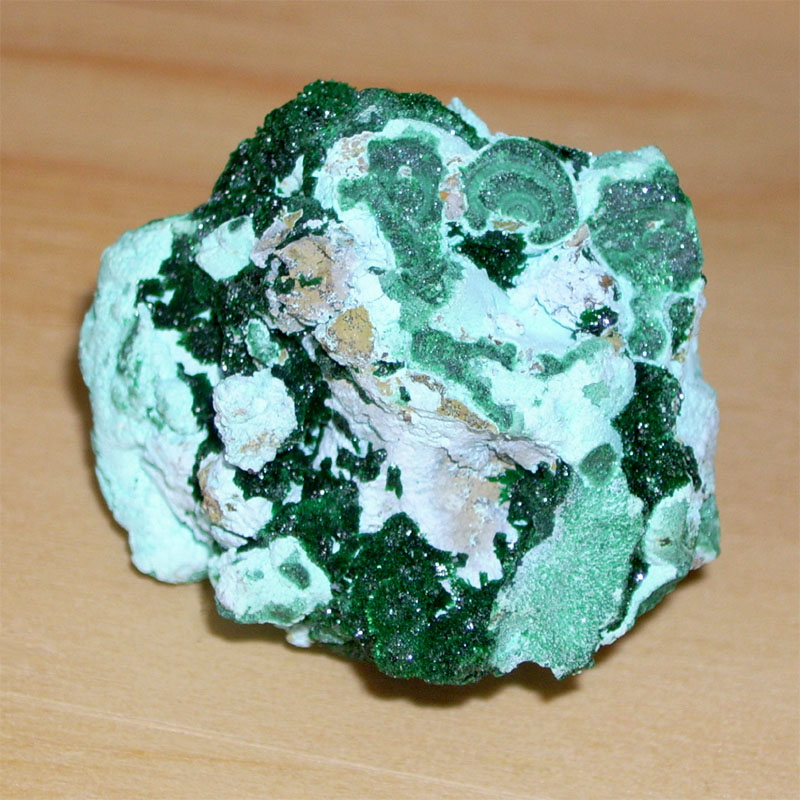
8.4 colodion photo process with vitriol as developer!
8.5 dry distillation
8.6 cyanide
Cyanides are produced by certain bacteria, fungi, and algae and are found in a number of plants. Cyanides are found in substantial amounts in certain seeds and fruit stones, e.g., those of apricots, apples, and peaches
In the cyanide process, finely ground high-grade ore is mixed with the cyanide (concentration of about two kilogram NaCN per tonne); low-grade ores are stacked into heaps and sprayed with a cyanide solution (concentration of about one kilogram NaCN per ton). The precious metals are complexed by the cyanide anions to form soluble derivatives, e.g., [Au(CN)2]− and [Ag(CN)2]−
4 Au + 8 NaCN + O2 + 2 H2O → 4 Na[Au(CN)2] + 4 NaOH
8.6.1 cyanotype
In a typical procedure, equal volumes of an 8.1% (w/v) solution of potassium ferricyanide: https://en.wikipedia.org/wiki/Potassium_ferricyanide
[In the 19th century, it was used for reading palimpsests and old manuscripts.]
and a 20% solution of ferric ammonium citrate are mixed. Rinse after this.
Different blueprint processes based on photosensitive ferric compounds have been used. The best known is probably a process using ammonium ferric citrate and potassium ferricyanide. In this procedure a distinctly blue compound is formed and the process is also known as cyanotype. The paper is impregnated with a solution of ammonium ferric citrate and dried. When the paper is illuminated a photoreaction turns the trivalent (ferric) iron into divalent (ferrous) iron. The image is then developed using a solution of potassium ferricyanide forming insoluble ferroferricyanide (Turnbell's blue identical to Prussian blue) with the divalent iron. Excess ammonium ferric citrate and potassium ferricyanide are then washed away.
[or…]
In a typical procedure, equal volumes of an 8.1% (w/v) solution of potassium ferricyanide and a 20% solution of ferric ammonium citrate are mixed.
This mildly photosensitive solution is then applied to a receptive surface (such as paper or cloth) and allowed to dry in a dark place. Cyanotypes can be printed on any surface capable of soaking up the iron solution. Although watercolor paper is a preferred medium, cotton, wool and even gelatin sizing on nonporous surfaces have been used. Care should be taken to avoid alkaline-buffered papers, which degrade the image over time.
Prints can be made from large format negatives and lithography film, Digital negative (transparency) or everyday objects can be used to make photograms.
A positive image can be produced by exposing it to a source of ultraviolet light (such as sunlight) as a contact print through the negative or objects. The combination of UV light and the citrate reduces the iron(III) to iron(II). This is followed by a complex reaction of the iron(II) complex with ferricyanide. The result is an insoluble, blue dye (ferric ferrocyanide) known as Prussian blue. The extent of color change depends on the amount of UV light, but acceptable results are usually obtained after 10–20 minute exposures on a dark, gloomy day.
After exposure, developing of the picture involves the yellow unreacted iron solution being rinsed off with running water.
[Note: DO NOT mix ferricyanide with any acid!]
see also: http://www.alternativephotography.com/wp/processes/cyanotype/photography-with-iron-iii-salt which focuses on ferric III sulphate
also:
http://www.alternativephotography.com/wp/processes/cyanotype/new-cyanotype-process
http://www.apug.org/forum/index.php?threads/how-to-get-a-better-blue-in-cyanotypes.10077/
iron II sulfate to II sulfate:
You can easily react Iron wool or Powder with warm %50 Sulfuric acid (this make Iron(II)Sulfate) and then add Hydrogen Peroxide(or nitric acid or even chlorine gas) for oxidation Fe2+ to Fe3+
8.6.2 The suicide of Alan Turing
… or an accident resulting from experiments with gold-plating by way of electrolysis of cyanide/gold solution…
8.6.3 testing for
Berlin Blue, Prussian Blue [Ferric ferrocyanide]:
Iron(II) sulfate (copperas) is added to a solution suspected of containing cyanide, such as the filtrate from the sodium fusion test. The resulting mixture is acidified with mineral acid (eg. hydrochloric, nitric?). The formation of Prussian blue is a positive result for cyanide.
tissue sample is added to 5% sodium hydroxide solution, which is in turn added to a solution containing 5% iron (II) sulfate and 1% iron (III) chloride. This is heated to 60˚C for 10 minutes, then transferred to a solution of hydrochloric acid. The appearance of a blue colouration, caused by the formation of the iron-cyanide complex known as Prussian blue, indicates the presence of cyanide ions in the original sample.
8.6.4 more berlin or prussian blue
- cyanotype above
- potassium ferricyanide and ferrous iron in acid solution produces Prussian Blue
- as an antidote to heavy metal poisoning with Thallium or Caesium
- discovered by Johann Conrad Dippel 1700 alchemist in Berlin - model for Frankenstein
- side note of ferrous sulphate in mushroom identification - see above
8.6.5 how it is used in gold extraction/and/or/electrolysis
9 processes TODO
- Washing silicon in muriatic acid. Best done outside as fumes are smelly but NOT dangerous. SITE? MATERIALS: muriatic acidX
- Making more silicon with thermite. EMPTY SITE. MATERIALS: aluminium powder
- Obtaining antimony. http://www.mindat.org/loc-618.html Possibly also location for:
- Melting/smelting/roasting of metal ores including antimony. EMPTY SITE. HIGH RISK in some cases. MATERIALS: furnace as below, charcoal pit roasting/charcoal, metal pans.
- Building forge/furnace for smelting. PETER PLACE. LOW RISK. MATERIALS: refractory cement, perlite, large tin, metal pipe
or forge can be made simply by carving SOFT fire/refractory bricks.
ceramic blanket: eg. http://www.bigceramicstore.com/cerablanket-fiber-blanket-1-linear-foot-2-sq-feet-8-1-thick-2-feet-wide.html
crucibles: http://www.gessweincanada.com/product-p/260-8050m.htm and http://www.gessweincanada.com/product-p/407-22781m.htm or we can try jewelery store…
and tools for getting crucible in/out of furnace?
- Thin film deposition. LAB or SITE?. MEDIUM RISK of some fumes so not indoors. MATERIALS: various chemistry (NYMOC contact), hotplateX, [atomizer], [diamond cutter], 35mm glass slides, filters, vinyl cement, silver paste, silicone, associate electronic parts for testing (to convert scope to curve tracer/arduino - see curve tracer notes)
- Nitric acid from air. OBORO?. LOW RISK. MATERIALS: neon transformer (Peter), thin copper tubing, plastic tubing, aquarium bubbler air, pump, glass bowl
- Culturing Th. Ferro bacteria. OBORO. LOW RISK. MATERIALS: wide glass tubes, stoppers, plastic tubing, metal mesh, other containers, distilled water - IN PROGRESS
[9) Sublimation - notes above…]
- Other processes which I might try if I have time so maybe not: Cyanotype, collodion, sublimation. OBORO. LOW RISK. MATERIALS: various chemistry, plastic trays
- Casting concrete, clay - IN PROGRESS - needs FIRING - pit kiln
- Recrystallisation of VITRIOL - IN PROGRESS
10 references
10.1 alchemy
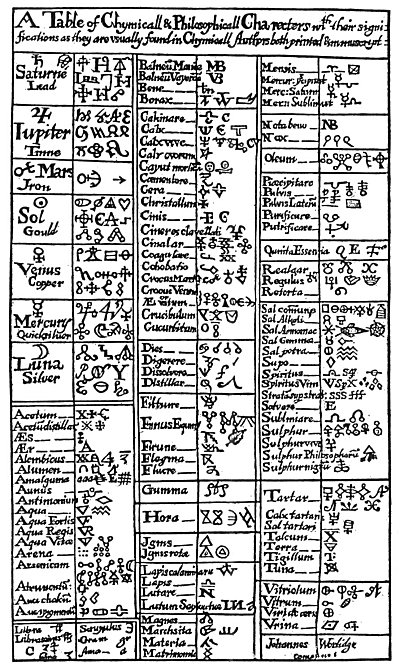
http://www.tpissarro.com/alquimia/fulcanelli-e.htm
Twelve Keys of Basil Valentine: http://www.levity.com/alchemy/twelvkey.html
Lapidus - In Pursuit of Gold: http://www.bibliotecapleyades.net/ciencia/esp_ciencia_lapidus2.htm
Principe lecture: https://www.youtube.com/watch?v=2Gc2YYPow6c
Adept Alchemy by Robert A. Nelson: http://www.levity.com/alchemy/nelson1_4.html
10.1.1 reference
aqua regia - nitric and hydrochloric - distilled from salpeter and sal ammoniac?
spirit of salt - hydrochloric acid
aqua fortis - nitric acid
oyl of vitriol - sulphuric acid (dry distilled from
salpeter - potassium nitrate
sal ammoniac - ammonium chloride
copperas - ferrous sulphate
10.2 refs/papers which are (extracted or in full) in field trip guide above:
Mineral acids: http://webapp1.dlib.indiana.edu/newton/reference/mineral.do
Rocks and minerals for the collector: Kirkland Lake - Rouyn-Noranda - Val-d'Or, Ontario and Quebec:
http://ftp.geogratis.gc.ca/pub/nrcan_rncan/publications/ess_sst/214/214759/mr_77_e.pdf
Saltpeter extraction: http://www.leeds.ac.uk/ims/fieldsofconflict/Report3.pdf
and http://www.leeds.ac.uk/ims/fieldsofconflict/Report12.pdf
Copper smelting in pit furnaces: http://www.ancient-arts.org/pentrwyn%20exp%20report.pdf
10.3 misc
PDMS, microfliudics?
improvising lab equipment: https://www.penflip.com/shikamikonotz/shika-na-mikono/blob/master/appendixA.txt
11 questions/directions
11.1 - 3 layers in cosmic retort and key emblem // 3 diagrams also
1- geomantic turing machine - owl TM - acid rain (horned owl feather MM mine)
2- stone taped turing machine - serpent TM - control/UNIVERSAL turing machine (salamander at Lac Nicolet antimony mine)

3- light and leaky turing machine - earth/toad TM - vessel and heating (frogs at Elder mine site?)
11.2 how might antimony via humida/vinegar/acetate path relate to thin film dep?
11.3 how could a leaky, light/dark binary taped Turing machine operate? how easy would it be to build a prototype?
Notes here and above…
reworking drops of acid and alkali/bicarbonate onto transparent film…. red cabbage pigment: http://www.coolscience.org/CoolScience/Teachers/Activities/CabbageJuice.htm
Babbage/Cabbage…
see also: https://github.com/mit-ll/TuringMachine
… and for example how a Turing machine can predict or work with star/planet movements and geomancy…
… or we can not use tape and would be some kind of horizontal conveyor over surfaces/rocks and so on…
Refs for workings: https://tspace.library.utoronto.ca/bitstream/1807/29830/1/Olley_Allan_DG_201106_PhD_thesis.pdf
11.4 Aspergillus niger?
Aspergillus niger growing from gold mining solution contained cyano metal complexes; such as gold, silver, copper iron and zinc. The fungus also plays a role in the solubilization of heavy metal sulfides.
11.5 constellations and antimony: regulus // and Corvus/crow (in Virgo) -> geomantic processor
"Two Stars are given by the Gods to man to lead him to great wisdom. Gaze steadily upon them, follow their lights, and you will find in them the secret of knowledge." [Valentine]
Example code also working a bit from Hawkins - Stonehenge Decoded just to get our bearings in Archaeo-astronomy….
TODO:
# date: 2/11/2016
import sys
import argparse
from pprint import pprint
import numpy as np
import ephem
from datetime import date
import urllib2
import random
#import time
from math import sin, cos, pi, asin, radians as rad,degrees as deg
from time import sleep
import os
import logging
################1- first try and make sense of declination and stonehenge decoded figures // Hawkins
# how does site line from observer through stones hit declination
# and how do we calculate this for long/lat? is for latitude only
# Sin d = (sin l x sin h) + (cos l x cos h x cos az)
# Where d = declination, l = latitude, h = horizon height and az = azimuth.
# lat for stonehenge = Decimal Latitude 51.178882 51 Minutes 10 Seconds 43.9752
# az for position G = 40.7 (degrees)
# In his book, Prof. North gives the following readings on the height
# of the natural horizon: NE .6-degrees; E .65-degrees; SE .7-degrees;
# SW .6-degrees; W .45-degrees; NW .3-degrees.
# sin 51 x sin .65 + cos 51 x cos 40.7 =0.4859 = approx sin for 29 -> inverse sin - so no pyephem
# skipped cos h!
# sin takes angle in radians so we need to convert to radians
angtorad=0.01745329252
azimuth=40.7 # 40.7 for position p.110 table 1
horizon=0.6 # adjust for angle
lat=51.1788882 # decimal degrees
d=((sin(lat * angtorad) * sin(horizon * angtorad)) + (cos(lat * angtorad) * cos(horizon * angtorad) * cos(azimuth* angtorad)))
#print asin(d)*180/pi # radians to degrees see also np.deg2rad
# figures don't quite match table 1 but are close
################2- print planets max and min declinations
# proof of concept for maximum
max=0.0
base=0
d = ephem.Date('-1500/1/1')
sun = ephem.Sun()
while base<3650: # 100 years
d+=1
base+=1
sun.compute(d)
degreez=deg(float(repr(sun.dec))) # this gives our decimal degrees
if degreez>max:
max=degreez
#print('sun max dec: %f' % degrees(max)) # how to do to decimal
#print max # for sun gives 23.92 which is max for moon 29.2 all agreeing with Hawkins
################3- our location and basic pyephem uses
# moon phases
g = ephem.Observer()
g.name='DISS'
g.lat=rad(45.521682) # OBORO - lat/long in decimal degrees find at: http://www.latlong.net/
g.long=rad(-73.574336)
m = ephem.Moon()
g.date = date.today()# local time zone, I'm in UTC+1
g.date -= ephem.hour # always everything in UTC
for i in range(24*4): # compute position for every 15 minutes
m.compute(g)
nnm = ephem.next_new_moon(g.date)
pnm = ephem.previous_new_moon(g.date)
# for use w. moon_phases.ttf A -> just past newmoon,
# Z just before newmoon
# '0' is full, '1' is new
# note that we cannot use m.phase as this is the percentage of the moon
# that is illuminated which is not the same as the phase!
lunation=(g.date-pnm)/(nnm-pnm)
symbol=lunation*26
if symbol < 0.2 or symbol > 25.8 :
symbol = '1' # new moon
else:
symbol = chr(ord('A')+int(symbol+0.5)-1)
# print(str(ephem.localtime(g.date).time()), deg(m.alt),deg(m.az),
# ephem.localtime(g.date).time().strftime("%H%M"),
# m.phase,symbol) # added str
g.date += ephem.minute*15
################4- constellations and antimony: regulus // and Corvus/crow (in Virgo) -> geomantic processor - we need 3...
# we have Regulus, Gienah Corvi (the Raven's Wing - star in constellation Corvus: http://stars.astro.illinois.edu/sow/gienah.html )
reg= ephem.star("Regulus")
degrees_per_radian = 180.0 / pi
# alt: up/down so minus is below horizon, azimuth: degrees from north
# so how could we start to map/plot or visualize this - see test.plot for gnuplot
# but how do we want to use this?
for i in range(24*4): # compute position for every 15 minutes for 24 hours
reg.compute(g)
# print('Time %s Regulus: altitude %4.1f deg, azimuth %5.1f deg' % (ephem.localtime(g.date).time().strftime("%H%M"), reg.alt * degrees_per_radian, reg.az * degrees_per_radian)) # or as in above we use deg() function
print(str(ephem.localtime(g.date).time()), deg(reg.alt),deg(reg.az),
ephem.localtime(g.date).time().strftime("%H%M"))
g.date += ephem.minute*15
################################################################################
# then try with PdeS location and maybe port in gpsgeomancy
# or look at other approaches to geomantic coding - entering crow constellation(south), metal planets, ON DISPLAY in gallery
################################################################################
# refs:
# http://www.celticnz.co.nz/US15.html
# http://www.geoastro.de/elevaz/basics/index.htm
# http://www.sherrytowers.com/hawkins_alignment_paper.pdf
# http://sherrytowers.com/2013/11/27/archaeoastronomy/
# http://rhodesmill.org/pyephem/radec.html
# http://michelanders.blogspot.ca/2011/01/moon-phases-with-pyephem.html
# http://rhodesmill.org/pyephem/tutorial.html
# https://ocefpaf.github.io/python4oceanographers/blog/2013/10/21/moon_ephem/
# http://michelanders.blogspot.ca/2011/01/moon-phases-with-pyephem.html
# Montreal/Minesotta 45 degrees: http://www.physics.csbsju.edu/astro/CS/CS.16.html
# ??? http://stackoverflow.com/questions/8634664/calculate-position-of-star-with-pyephem
11.6 glass/mirrors
Dee astronomy reference in Shumaker p.69+ and Lister ref. above…
Also:
CABALA: SPIEGEL DER KUNST VND NATUR. - CABALA Mirror of Art and Nature – Stephan Michelspacher

[This is the image we use for Shift Register project.]
From: http://atrightanglestoreality.blogspot.ca/2016/05/stephan-michelspacher-cabala-mirror-of.html
Its short text, partly in verse-form, describes three steel mirrors forged by the heat of the sun and revealed by the grace of God, which are at least partly metaphorical. When combined together, these mirrors – which reflect the Paracelsian triumvirate of mercury, salt and sulphur – reveal the great Arcanum, or secret of alchemical transmutation.
11.7 using our own breath as distillation or circulation medium for minerals - possibly for workshop!
12 diagrams
13 software notes
13.1 software notes
Geomantic ouroboric Python software runs:
- Turing machine (simulation and control based on a reading of light and dark and/or planets/stars)
what is TM? busy beaver or dictated by stars?
- Pyephem for star movements (plotted ascii) - Corvus, Regulus, Sun and Moon
- Geomancy based on the above star movements and light and dark/TM status
- Monitors: temperature (within say digester)
- Controls: stepper of TM, CDROM DC motor movement, switching pumps
- Displays: ascii plot of star movements, TM status, temperature, geomancy
13.1.1 pi
we need in rc.local
/usr/bin/python /home/pi/i2canddarkness.py
dd bs=4M if=Downloads/2016-09-23-raspbian-jessie-lite.img of=/dev/sdb
get IP/connect:
nmap -sn 192.168.3.0/24
ssh pi@192.168.3.202
- what we need to work with is i2c->arduino and camera/python
for numpy:
sudo apt-get install python-dev
sudo apt-get install libatlas-base-dev
sudo apt-get install python-numpy
- test code
to gauge light and dark from camera…
first we need to enable camera in raspi-config
- when arduino asks return light and dark via GPIO or I2C DONE - well we don;t ask just get!
import time import picamera import numpy as np width = 32 height = 32 fwidth = (width + 31) // 32 * 32 fheight = (height + 15) // 16 * 16 # Capture the image in YUV format with picamera.PiCamera() as camera: camera.resolution = (width, height) while(1): stream = open('image.data', 'w+b') camera.start_preview() # time.sleep(2) camera.capture(stream, 'yuv') # Rewind the stream for reading stream.seek(0) # Calculate the actual image size in the stream (accounting for rounding # of the resolution) # Load the Y (luminance) data from the stream Y = np.fromfile(stream, dtype=np.uint8, count=fwidth*fheight) total=0; for xx in Y: total += xx print "DARKNESS", total - i2c
Following: https://oscarliang.com/raspberry-pi-arduino-connected-i2c/
more or less with ref also to: http://learn.adafruit.com/adafruits-raspberry-pi-lesson-4-gpio-setup/configuring-i2c - as in just enable it!
for arduino we needed it to reboot to show up under:
i2cdetect -y 1
Arduino always recieves new darkness value and prints this to serial (for test purposes) in main loop:
#include <Wire.h> #define SLAVE_ADDRESS 0x04 int number = 0; int state = 0; int darkness = 0; void setup() { pinMode(13, OUTPUT); Serial.begin(9600); // start serial for output // initialize i2c as slave Wire.begin(SLAVE_ADDRESS); // define callbacks for i2c communication Wire.onReceive(receiveData); Serial.println("Ready!"); } void loop() { Serial.print("darkness: "); Serial.println(darkness); delay(100); } // callback for received data void receiveData(int byteCount){ while(Wire.available()) { darkness = Wire.read(); } }and on pi:
import smbus import time import picamera import numpy as np # i2c setup # for RPI version 1, use bus = smbus.SMBus(0) bus = smbus.SMBus(1) # This is the address we setup in the Arduino Program address = 0x04 def writeNumber(value): bus.write_byte(address, value) # bus.write_byte_data(address, 0, value) return -1 width = 32 height = 32 fwidth = (width + 31) // 32 * 32 fheight = (height + 15) // 16 * 16 # Capture the image in YUV format with picamera.PiCamera() as camera: camera.resolution = (width, height) while(1): stream = open('image.data', 'w+b') camera.start_preview() # time.sleep(2) camera.capture(stream, 'yuv') # Rewind the stream for reading stream.seek(0) # Calculate the actual image size in the stream (accounting for rounding # of the resolution) # Load the Y (luminance) data from the stream Y = np.fromfile(stream, dtype=np.uint8, count=fwidth*fheight) total=0; for xx in Y: total += xx total=total/1024 print "DARKNESS", total # send darkness to i2c/arduino writeNumber(total) import smbus import time import picamera import numpy as np # i2c setup # for RPI version 1, use bus = smbus.SMBus(0) bus = smbus.SMBus(1) # This is the address we setup in the Arduino Program address = 0x04 def writeNumber(value): bus.write_byte(address, value) # bus.write_byte_data(address, 0, value) return -1 width = 32 height = 32 fwidth = (width + 31) // 32 * 32 fheight = (height + 15) // 16 * 16 # Capture the image in YUV format with picamera.PiCamera() as camera: camera.resolution = (width, height) while(1): stream = open('image.data', 'w+b') camera.start_preview() # time.sleep(2) camera.capture(stream, 'yuv') # Rewind the stream for reading stream.seek(0) # Calculate the actual image size in the stream (accounting for rounding # of the resolution) # Load the Y (luminance) data from the stream Y = np.fromfile(stream, dtype=np.uint8, count=fwidth*fheight) total=0; for xx in Y: total += xx total=total/1024 print "DARKNESS", total # send darkness to i2c/arduino writeNumber(total) - refs
13.1.2 TM
but question of symbols?
file:///root/projects/dissolution/software/turing_machines/TuringMachine/src/tmachine
13.1.3 controlling
how we connect to arduino: http://stackoverflow.com/questions/27510578/how-to-get-arduino-port-with-python
- TM: stepper (arduino will on init return to zero position so we just need to keep check of all steps. Full step-width = ?)
[light and dark reading question - raspberry with i2c to arduino - pins?]
- TM: 2x pumps (FET or relay via. arduino)
- CDROM star light and dark DC motor (with trigger on arduino when we hit zero) - how we do this with 2 shields/2 arduinos?
13.1.4 monitoring
- temperature [MAX6675]
- light and dark relayed from rpi->arduino or circuit->arduino
13.1.5 display mockup
- alchemy quotation from list depending on light/dark or…
- ouroboric status registers: temperature, TM (light/dark, state)
- star/planet plots (how?)
- geomantic figure and intepretation ported from gpsgeomancy
13.2 final code
13.2.1 Arduino code for pumps, steppers, and cdrom positioning
#include <Wire.h>
#include <max6675.h>
#define SLAVE_ADDRESS 0x04
int number = 0;
int state = 0;
int darkness = 0;
// for cdrom motor
int E1 = 5;
int M1 = 4;
// for stepper
int cyclemb=7;
int inputstep=6; // stepper switch
int step=2;
int dirr=3;
int whereweare=0;
int cdrompos=1;
// cdrom switch will be on 8
int cdswitch=8;
// for pumps. FET on 9 and 10
int dark=10;
int light=9;
// and try for temperature thing on 11,12,13
int thermo_so_pin = 11;
int thermo_cs_pin = 12;
int thermo_sck_pin = 13;
MAX6675 thermocouple(thermo_sck_pin, thermo_cs_pin, thermo_so_pin);
void setup() {
pinMode(13, OUTPUT);
Serial.begin(9600); // start serial for output
// initialize i2c as slave
Wire.begin(SLAVE_ADDRESS);
// define callbacks for i2c communication
Wire.onReceive(receiveData);
// cdrom motor
pinMode(M1, OUTPUT);
pinMode(E1, OUTPUT);
// cdrom switch
pinMode(cdswitch, INPUT_PULLUP);
// stepper board old school
pinMode(inputstep, INPUT_PULLUP);
pinMode(dirr, OUTPUT);
pinMode(step, OUTPUT);
// power to motherboard
pinMode(cyclemb, OUTPUT);
// pumps
pinMode(dark, OUTPUT);
pinMode(light, OUTPUT);
// zero stepper and set whereweare to 0
// do_zero();
}
void do_mbon(){
digitalWrite(cyclemb,HIGH);
}
void do_mboff(){
digitalWrite(cyclemb,LOW);
}
void do_zero(){
// for stepper - move left till we register HIT!
int havewehit=0;
while (havewehit==0){
digitalWrite(dirr,LOW); // is left
digitalWrite(step,HIGH);
delay(1); // re-test
digitalWrite(step,LOW);
havewehit=digitalRead(inputstep);
// Serial.println(havewehit);
}
whereweare=0;
}
void do_left(){
// keep track of where we are!
if (digitalRead(inputstep)==1) whereweare=0;
else {
digitalWrite(dirr,LOW); // is left
digitalWrite(step,HIGH);
delay(10); // re-test
digitalWrite(step,LOW);
whereweare-=1;
}
// and if we hit sensor then update where we are...
}
void do_middle(){
// get to the middle
if (whereweare!=900){
do_zero();
while (whereweare<900){
whereweare+=1;
digitalWrite(dirr,HIGH); // is right
digitalWrite(step,HIGH);
delay(10);
digitalWrite(step,LOW);
}
}
}
void do_right(){
whereweare+=1;
if (whereweare<1800){
digitalWrite(dirr,HIGH); // is right
digitalWrite(step,HIGH);
delay(10);
digitalWrite(step,LOW);
// Serial.println(whereweare);
}
// else do_zero();
}
void do_cdrom_up(){
// best would be to zero and move to required spot - how we signal that spot? - leave as it is
// for now just do increments
int value=150; // right value for inertia
if (cdrompos<170){
digitalWrite(M1,HIGH); // low is back down
analogWrite(E1, value); //PWM Speed Control
delay(10); // small incremenr
analogWrite(E1, 0); //PWM Speed Control
cdrompos++;
}
// how far we can go up? say to 170 increments
// Serial.println(cdrompos);
}
void do_cdrom_down(){
// best would be to zero and move to required spot - how we signal that spot? - leave as it is
// for now just do increments
int value=150; // right value for inertia
// hit switch
if (digitalRead(cdswitch)==0) cdrompos=0;
else {
digitalWrite(M1,LOW); // low is back down
analogWrite(E1, value); //PWM Speed Control
delay(10); // small incremenr
analogWrite(E1, 0); //PWM Speed Control
cdrompos--;
}
}
void do_zero_cdrom(){
// down until we hit cdswitch - pullup to gnd
while(digitalRead(cdswitch!=0)){
do_cdrom_down();
}
cdrompos=0;
}
void do_write(){
// in this case just flash the LED-
digitalWrite(LED_BUILTIN, HIGH);
delay(100);
digitalWrite(LED_BUILTIN, LOW);
delay(100);
}
void do_pump_dark(){
// for certain time???
digitalWrite(dark, HIGH);
delay(10);
digitalWrite(dark, LOW);
// delay(1000);
}
void do_pump_light(){
// for certain time???
digitalWrite(light, HIGH);
delay(10);
digitalWrite(dark, LOW);
// delay(1000);
}
void loop() {
do_zero_cdrom();
// do_cdrom_up();
// do_pump_dark();
// deal with commands - what are they?
uint8_t c;
if(Serial.available()){
c = Serial.read();
switch(c){
case 'W': // write
// do_write();
do_pump_dark();
break;
case 'N': // how we could get this to go to value...
do_cdrom_up();
break;
case 'n':
do_cdrom_down();
break;
case 'L':
do_left();
break;
case 'R':
do_right();
break;
case 'M':
do_middle();
break;
case 'H':
do_mbon();
break;
case 'O':
do_mbon();
break;
}
}
// print darkness and temperature - also where motor is?
// get temperature
int temperature=thermocouple.readCelsius()*10.0;
// Serial.print("darkness: ");
// darkness=1;
/* Serial.print(darkness); */
/* Serial.print(" "); */
/* Serial.print(temperature); // print as ints - one byte 0-255??? */
/* Serial.print("\n"); */
delay(10);
}
// callback for received data
void receiveData(int byteCount){
while(Wire.available()) {
darkness = Wire.read();
}
}
13.2.2 Python ourobori.py running TM, star simulations.
# Geomantic ouroboric Python software runs // pair with arduino i2cwithpi
# must be in front window
# TODO: tested in chroot for dependencies, test running with arduino on DELL and localtime!
# *******////TM operations and program
# DONE@
# how CDROM light dark - if is above our horizon as in plot then move to show x light
# orientation - 50 degrees - TEST - orient to front window 120 to 300 degrees
# geomancy is DONE
# at what times do our 2 stars rise/set? PLOT THIS - minus 5 hours from UTC
# REG: rise 70deg at 5am (12midnight) // set 270deg 6pm = 1pm height = 60deg
# CORVUS: rise 120deg at 9am (5am) // set 250deg 6pm = 1pm height = 30deg
#//////////////////////////////////////////////////////////////
# ...................... DESC
# Turing machine (simulation and control based on a reading of light and dark //and/or// planets/stars)
# what is TM? busy beaver or dictated by stars?
# Pyephem for star movements (plotted ascii) - Corvus, Regulus, Sun and Moon
# Geomancy based on the above star movements and light and dark/TM status
# Monitors: temperature (within digester)
# Controls: stepper of TM, CDROM DC motor movement, switching pumps
# Displays: ascii plot of star movements, TM status, temperature, geomancy
#////////////////////////////
import sys
import argparse
from pprint import pprint
import numpy as np
import ephem
import datetime
import random
from math import sin, cos, pi, asin, radians as rad,degrees as deg
import time
from time import sleep
import os
import logging
import serial
import subprocess as sp
# dict for figures
figdict={'0010': ['Puer','Mars','Fire','Aries','+','Boy, yellow, beardless'], '0101': ['Amissio','Venus','Earth','Taurus','-','Loss, comprehended without'], '1101': ['Albus','Mercury','Air','Gemini','-','White, fair'], '1111': ['Populus','Moon','Water','Cancer','-','People, congregation'], '1100': ['Fortuna Major','Sun','Fire','Leo','+','Greater fortune, greater aid,safeguard entering'], '1001': ['Conjunctio','Mercury','Earth','Virgo','+','Conjunction, assembling'], '0100': ['Puella','Venus','Air','Libra','+','A girl, beautiful'], '1011': ['Rubeus','Mars','Water','Scorpio','-','Red, reddish'], '1010': ['Acquisitio','Jupiter','Fire','Sagitarrius','+','Obtaining, comprehending without'], '0110': ['Carcer','Saturn','Earth','Capricorn','+','A prison, bound'], '1110': ['Tristitia','Saturn','Air','Aquarius','-','Sadness, damned, cross'], '0111': ['Laetitia','Jupiter','Water','Pisces','-','Joy, laughing, healthy, bearded'], '0001': ['Cauda Draconis','Saturn & Mars','Fire','Scorpio','-','The threshold lower, or going out'], '1000': ['Caput Draconis',' Jupiter & Venus','Earth','Capricorn','+','The Head, the threshold entering, the upper threshold'], '0011': ['Fortuna Minor','Sun','Fire','Leo','-','Lesser Fortune, lesser aid, safeguard going out'], '0000': ['Via','Moon','Water','Cancer','+','Way, journey']}
roman=['0','I','II','III','IV','V','VI','VII','VIII','IX','X','XI','XII','XIII','XIV','XV','XVI']
#mapped to Crowley
crowley=['0','X','I','IV','VII','XI','II','V','VIII','XII','III','VI','IX','XIII','XIV','XV','XVI']
def inttodot(integer):
"""
Convert an integer to divination dots, two dots if the integer
is even, one if odd, two if zero
Takes an integer argument, returns a string of two dotchars or
one
"""
dotchar = "*"
if integer % 2 == 0:
dot = dotchar * 2
else:
dot = dotchar + " " # The addition of a space helps the
# final diagram line up
return dot
def oddoreven(integer):
if integer % 2 == 0:
dot = 1
else:
dot = 0
return dot
def domothers():
""" Append binary representation 0 as O/odd, 1 as OO/even
"""
motherlist=[]
for x in range(4):
binrep=[]
for body in range(4):
binrep.append(oddoreven(darknn[(x*4)+body]))
motherlist.append(binrep)
# print motherlist
return motherlist
def dodaughters(motherlist):
daughterlist=[]
body=zip(*motherlist)
for parts in body:
daughterlist.append(parts)
return daughterlist
def madd(x,y):
return int(not(x ^ y))
def donephews(mlist,dlist):
nlist=[]
nlist.append([madd(mlist[0][0],mlist[1][0]),madd(mlist[0][1],mlist[1][1]),madd(mlist[0][2],mlist[1][2]),madd(mlist[0][3],mlist[1][3])])
nlist.append([madd(mlist[2][0],mlist[3][0]),madd(mlist[2][1],mlist[3][1]),madd(mlist[2][2],mlist[3][2]),madd(mlist[2][3],mlist[3][3])])
nlist.append([madd(dlist[0][0],dlist[1][0]),madd(dlist[0][1],dlist[1][1]),madd(dlist[0][2],dlist[1][2]),madd(dlist[0][3],dlist[1][3])])
nlist.append([madd(dlist[2][0],dlist[3][0]),madd(dlist[2][1],dlist[3][1]),madd(dlist[2][2],dlist[3][2]),madd(dlist[2][3],dlist[3][3])])
return nlist
def dowitnesses(nlist):
wlist=[]
wlist.append([madd(nlist[0][0],nlist[1][0]),madd(nlist[0][1],nlist[1][1]),madd(nlist[0][2],nlist[1][2]),madd(nlist[0][3],nlist[1][3])])
wlist.append([madd(nlist[2][0],nlist[3][0]),madd(nlist[2][1],nlist[3][1]),madd(nlist[2][2],nlist[3][2]),madd(nlist[2][3],nlist[3][3])])
return wlist
def dojudge(wlist):
jlist=[]
jlist.append([madd(wlist[0][0],wlist[1][0]),madd(wlist[0][1],wlist[1][1]),madd(wlist[0][2],wlist[1][2]),madd(wlist[0][3],wlist[1][3])])
return jlist
def dorec(jlist,mlist):
rlist=[]
rlist.append([madd(mlist[0][0],jlist[0][0]),madd(mlist[0][1],jlist[0][1]),madd(mlist[0][2],jlist[0][2]),madd(mlist[0][3],jlist[0][3])])
return rlist
def drawit(listere):
""" run thru list and print whole list line by line"""
# must reverse listy
listy=list(listere)
listy.reverse()
body=zip(*listy)
for parts in body:
for part in parts:
if part==1:
print " O O ",
else:
print " O ",
print
numeral=0
def drawfig(body):
for part in body:
if part==1:
print " O O ",
else:
print " O ",
print
def lookfig(figure):
# convert list to string
key=''.join(str(e) for e in figure)
# return (' '.join((roman[numeral]+". GD:",crowley[numeral]+".",figdict[key][0],figdict[key][2],figdict[key][5])))
return (' '.join((figdict[key][0],": ",figdict[key][2],figdict[key][5],figdict[key][4])))
# list quotations
alchquotes = [
"Two Stars are given by the Gods to man to lead him to great wisdom. Gaze steadily upon them, follow their lights, and you will find in them the secret of knowledge.",
"Let the waters above the heavens fall\nand the earth will yield its fruit",
"A serpent and a toad coming up above the earth, a flying eagle",
"Serpents et Bufo gradiens super terram, Aquila volans",
"The red man here to his white wyfe,\nYs maryed with the spryte of life",
"Prima Materia Anima Corpus",
"A King on the left side and a Queen on the right standing in an open landscape.",
"The King holds a sceptre in his right hand and the Queen holds a three-blossomed flower in her right hand and a peacock feather fan in her left.",
"In front of the King a wolf or jumps over a triangular crucible placed on a basin of fire.",
"In front of the Queen, an old man with a scythe and crippled leg (a Saturn figure) steps across a fire on which a vessel (Cupel) is being heated.",
"There is one stone, one medicine, one vessel, one method, one disposition.",
"In our water all modes of things are brought about...\nIn the said water they are made as in an artificial vessel, which is a mighty secret.",
"The eagle flying through the air and the toad crawling on the ground are the magistry.",
"Join together an earthly toad and a flying eagle; you see the magesterium in our art.",
"To make the body spiritual, to make the spirit corporeal and consubstantial and fixed with the body; and to cleanse the filthie originall.",
"Let my friend know that no impure or spotted things are useful for our purpose.",
"Refuse the air below the earth rises\nand the sky will not withold its decay.",
"I tell you that they have reinvented geology in order to impose a new idea of god.",
"A contrary element, namely earth, whereon alone it moves by slow steps, and does not trust itself to another element.",
"Its head is very heavy and gazes at the earth\nit is firm and solid\nUpon it as a foundation the Golden House is to be built.",
"There are three diagrams or emblems.",
"When I had emptied to the dregs the cup of human suffering, I was led to consider the wretchedness of this world, and the fearful consequences of our first parents' disobedience.",
"EVERYTHING in existence necessarily has a body. The mode and manner may be understood as being like a smoky spirit, which indeed has substance, but is not a body, nor is it tangible.",
"SUN, CISCO, DELL, PENTIUM-4, DDR-4, SATA, SCSI, DIGITAL, PDP, ASTRATA, GLENCORE",
"LAIR, shrine, knife, circle, lighter, fire, beer, SUN microsystems, tunnel, stain, keyboard, AMD-Acid Mine Drainage.",
"Cracked snow white as a binary one or zero against the darkness.",
"Death may come before earth and love.",
"No more fruit, no more trees, no more vegetables, no more plants pharmaceutical or otherwise and consequently no more food.",
"The Rite of the Black Sun.",
"Spiritus, Anima, Corpus.",
"The true antimony of the philosophers lies in the deep sea, that the son of the king may lurk submerged.",
"We will suppose that the computer works in such a dissolutory manner that he never does more than one step at a sitting.",
"Visit the interior of the earth, and by rectifying (correcting or purifying) what you find there, you will discover the hidden stone.",
"... a Turing machine M could be constructed that would respond to a set of quintuples on its tape by printing | if and only if the machine defined by that set of quintuples never prints | when started with its own set of quintuples. Now, what happens when M is started with its own set of quintuples on its tape?",
"Of the black earth, wherein the seven planets took root.",
"The deep is its clothing, above it shall stand water, air, fire, and the birds of the air shall dwell therein, watering it from the upper elements, that it may be filled with the fruit of their works, because in the centre of the earth the seven planets took root, and left their virtues there, wherefore in the earth is water germinating divers kinds of colours and fruits and producing bread and wine that cheereth the heart of man.",
"When thou hast water from earth, air from water, fire from air, earth from fire, then thou fully and perefectly possess our art.",
"... and the earth hath been polluted and defiled in my works; for there was darkness over it, because I stick fast in the mire of the deep and my sustance is not disclosed.",
"... that the element of earth is not earth only, but a grape as well, that the element of water is not water only, but a mineral as well.",
"This man of copper whom you have seen is the sacrificial priest and the sacrifice and he who vomited out his own flesh. To him was given authority over the water and over those men in mortification.",
"by such a dissolution and sublimation, the spirit is converted into a body and the body into a spirit.",
"One serpent holds in his mouth the tail of the other, to show that they are indissolubly conjoined by community of birth and destiny, and that our art is accomplished by the joint working of this mercurial sulphur, and the sulphurous mercury.",
"Take the flying bird and drown it flying, and divide it and separate it from its pollutions. Draw it forth and repel it from itself.",
"Wherefore, let our body remain in the water till it is dissolved into a subtile powder in the bottom of the vessel and the water, which is called the black ashes; this is the corruption of the body which is called by the philosophers or wise men, Saturnus plumbum philosophorum, and pulvis discontinuatus, viz. saturn, latten or brass, the lead of the philosophers the disguised powder. And in this putrefaction and resolution of the body, three signs appear, viz., a black color, a discontinuity of parts, and a stinking smell, not much unlike to the smell of a vault where dead bodies are buried. These ashes then are those of which the philosophers have spoken so much which remained in the lower part of the vessel, which we ought not to undervalue or despise; in them is the royal diadem, and the black and unclean argent vive, which ought to be cleansed from its blackness, by a continual digestion in our water, till it be elevated above in a white color, which is called the gander, and the bird of Hermes. He therefore that maketh the red earth black, and then renders it white, has obtained the magistery. So also he who kills the living, and revives the dead. Therefore make the black white, and the white black, and you perfect the work.",
"The earth is cold and dry, cold and moist, warm and dry, warm and moist. This is how matters stand. Whatever thing which is warm and dry grows out of the earth, grows out of that which in the earth is warm and dry. Whatever is or is produced cold and moist, is produced from that in the earth which is of a similar nature.",
]
darknn=[1,2,3,4,5,6,7,8,9,10,11,12,13,14,15,16]
count=0
ready=1
darkness=0
temperature=1.0
turing_states=["write 0", "write 1", "read 0", "read 1"]
data=""
# where is arduino on serial? pass as argument
parser = argparse.ArgumentParser(description="serial")
# add expected arguments
parser.add_argument('--port', dest='port', required=True)
args = parser.parse_args()
ser = serial.Serial(args.port, 9600, parity=serial.PARITY_NONE,\
stopbits=serial.STOPBITS_ONE,\
bytesize=serial.EIGHTBITS,\
timeout=1)
sleep(3)
g = ephem.Observer()
g.name='DISS'
g.lat='45.5270833' #PDS
g.long='-73.5952694'
g.horizon=0
g.elevation=68
# init geomantics/ephem
sun = ephem.Sun()
moon = ephem.Moon()
reg= ephem.star("Regulus")
corvus= ephem.star("Gienah Corvi")
degrees_per_radian = 180.0 / pi
tmpos=0 # middle - or do we get pos from arduino?
cdrompos=0
# startup: tell arduino to zero Tm motor - middle
# new calibration code
ser.write("M") # middle
# read darkness to get average
for x in range(16):
ser.write("L")
ser.write("L")
ser.write("L")
ser.write("L")
ser.write("L")
ser.flushOutput()
ser.flushInput()
ser.write("Q")
sleep(1)
try:
line = ser.readline()
data = [val for val in line.split()]
# ser.flushInput()
except KeyboardInterrupt:
print('exiting')
# if data is longer than 1
if len(data)>0:
# if isinstance(data[0],int):
try:
darkness=int(data[0]) # darkness
except:
darkness=0
darknn[count]=darkness
count+=1
count=0
threshold=sum(darknn)/len(darknn)
ser.write("P") # zero TM stepper <
# zero cdrom motor
ser.write("Z")
# try and port in TM
# init TM
# we need to write TAPE first...
prog = [[(1, +1, 1), (1, +1, 0)], # state 0
[(0, -1, 2), (1, +1, 1)], # state 1
[(0, +1, 2), (0, +1, 9)]] # state 2
tape = [1,1,0,1,1,1,0,0,0] # The data tape
head = 0 # head position on tape
state = 0 # instruction pointer
# threshold = 60
# write tape
for things in tape:
if things==0:
# write zero
ser.write("E")
else:
ser.write("W")
ser.write("R") # move right
sleep(1)
# zero head
ser.write("P") # zero TM stepper
while(1):
# request data
ser.flushOutput()
ser.flushInput()
ser.write("Q")
sleep(.1)
try:
line = ser.readline()
data = [val for val in line.split()]
# ser.flushInput()
except KeyboardInterrupt:
print('exiting')
# if data is longer than 1
if len(data)>0:
# if isinstance(data[0],int):
try:
darkness=int(data[0]) # darkness
except:
darkness=0
# if isinstance(data[1],float):
# temperature=data[1]/10.0 # temperature
# record 16 darkness values for geomancy
darknn[count]=darkness
count+=1
if count==16:
count=0
ready=1
# test code
# darkness=random.randint(0,512)
darknn[count]=darkness
count+=1
if count==16:
count=0
ready=1
tmp = sp.call('clear',shell=True)
print " TEST EXECUTION HOST"
print " +++++++++++++++++++"
print "Decoding ancient alchemical texts and emblems as (literal) instructions for the construction, execution and maintenance of a contemporary, geomantic and necessarly ouroboric live processor."
# print time
print
print random.choice(alchquotes) # or this choice is dependent of darkness!
# print registers -
print " Digester temperature: disconnected Darkness: %d Threshold: %d" %(darkness, threshold)
print " Turing Machine Status:"
# run TM:
if state==9:
head=0
state=0
# symbol = tape[head] # read current tape symbol - read dark or light
if darkness>threshold:
symbol=1
else:
symbol=0
# symbol=random.randint(0,1)
symbol, dir, state = t = prog[state][symbol] # lookup instruction
print " ",
print(tape)
print " ",
print(' ' * (head * 3 + 1)+ '^ ' + str(t)) # display progress
if head>=len(tape):
tape.append(symbol)
else:
tape[head] = symbol # write new symbol on tape - write dark or light
if symbol==0:
# write zero
ser.write("E")
else:
ser.write("W")
head = head + dir # move tape head
if dir==1:
ser.write("R")
else:
ser.write("L")
# if head is too far over or left then move to middle -
if head<0:
ser.write("M")
head=200 # what is middle? 1800/4 = 400 say
if head>400:
ser.write("M")
head=200 # what is middle? 1800/4 = 400 say
# planet calculations and plots
g.date = datetime.datetime.utcnow()#
reg.compute(g)
print "REGULUS:",
print ephem.localtime(g.date), deg(reg.az),deg(reg.alt)
corvus.compute(g)
print "CORVUS - Gienah Corvi:",
print ephem.localtime(g.date), deg(corvus.az),deg(corvus.alt) # wrong localtime is set here on laptop - IGNORE!
# plot the planets...
# we have altitude and azimuth - horizon [------------------------] where to where? orient to 0 north in PDS
# say 80 lines across for azimuth = round 360/80=/4.5 but we just want 180 = /9
# say 10 lines for altitude (range 0to90) = /2.25
# REGULUS - check/TEST!
print
print "REGULUS position: az/alt"
# degrees is starting at 304 [wrap 360] to 124 (180
# for back wall - for front window we do 120 to 300 say
degg=deg(reg.az)
if degg>120 and degg<300: # upto 300 - 180
xcoord=int((degg-120)/2.25)
else:
xcoord=-1
if deg(reg.alt)>0.0:
ycoord=np.ceil(deg(reg.alt)/9.0)
else:
ycoord=-1 # below horizon
print xcoord,ycoord
for y in range(10):
print"|",
if (10-ycoord)==y:
if xcoord>0:
for x in range(xcoord):
print "",
print "O"
else:
print
print"--------------------------------------------------------------------------------"
print
print "CORVUS - Gienah Corvi position: az/alt"
# same as above
degg=deg(corvus.az)
if degg>120 and degg<300: # upto 300 - 180
xcoord=int((degg-120)/2.25)
else:
xcoord=-1
if deg(corvus.alt)>0.0:
ycoord=np.ceil(deg(corvus.alt)/9.0)
else:
ycoord=-1 # below horizon
print xcoord,ycoord
for y in range(10):
print"|",
if (10-ycoord)==y:
if xcoord>0:
for x in range(xcoord):
print "",
print "O"
else:
print
print"--------------------------------------------------------------------------------"
print
# Planet-light HOW?
# if is above horizon in our 180 degrees then move according to...
# arduino commands: move up/darken =N, down/lighten=n, zero=Z
# note that DOWN is more LIGHT
# test code with the sun!
sun.compute(g)
moon.compute(g)
# divide degrees of corvus to extent which is 170 - extent is depending ON VOLTAGE!
# this is position we need to get to (inverted) 170-cdrompos
# if we run to zero then do this as explicit Z
# TODO: was corvus
if deg(sun.alt)>0.0:
wherepos=200-(np.ceil(deg(sun.alt)*6.0)) # 30 degrees and we 200 incs
else:
wherepos=200
# go there
print "SUN:", deg(sun.alt),
print "MOON:", deg(moon.alt)
# wherepos=200
if wherepos==0:
ser.write("Z")
cdrompos=0
while wherepos>cdrompos:
ser.write("N")
cdrompos+=1
while wherepos<cdrompos:
ser.write("n")
cdrompos-=1
# run geomantics
# house = VIII. Death/Mortis - The House of Slaughter and Death: Heaviness, sadness, enemies, long torments, imprisonment, and the quality of death.
# this would be the 4th daughter
if ready==1:
mlist=domothers()
dlist=dodaughters(mlist)
ready=0
print "House = VIII. Death/Mortis - The House of Slaughter and Death: Heaviness, sadness, enemies, long torments, imprisonment, and the quality of death."
# take the fourth daughter and explain/display this
chosen=dlist[3]
print lookfig(chosen) # TODO: clean up a bit but works
drawfig(chosen)
sleep(20)
ser.close()
14 for a reader
- this document
- alchemy material (see fieldtrip guide and techniques) - key texts
- oswald wiener and simple turing machine explanations
- stonehenge
- there is no software
- crystal world
15 working group
The Dissolutions working group aims to meet once a week on a Wednesday through October and November either at OBORO or on various relevant sites in Montreal, to discuss, research and conduct practical experiments in dissolution. Participation is free. Please register to receive further details of Dissolution working group actions: m_at_1010.co.uk
The second meeting will take place at 7.30PM Wednesday 2nd November at Oboro, 4001 Berri.
[The first meeting TOOK place on Wednesday 26 October, meeting at 3PM at Redpath Museum, McGill: https://www.mcgill.ca/redpath/]
16 workshop/s and calls
16.1 Circulation: Extraction and (Earth) Return workshop with Martin Howse
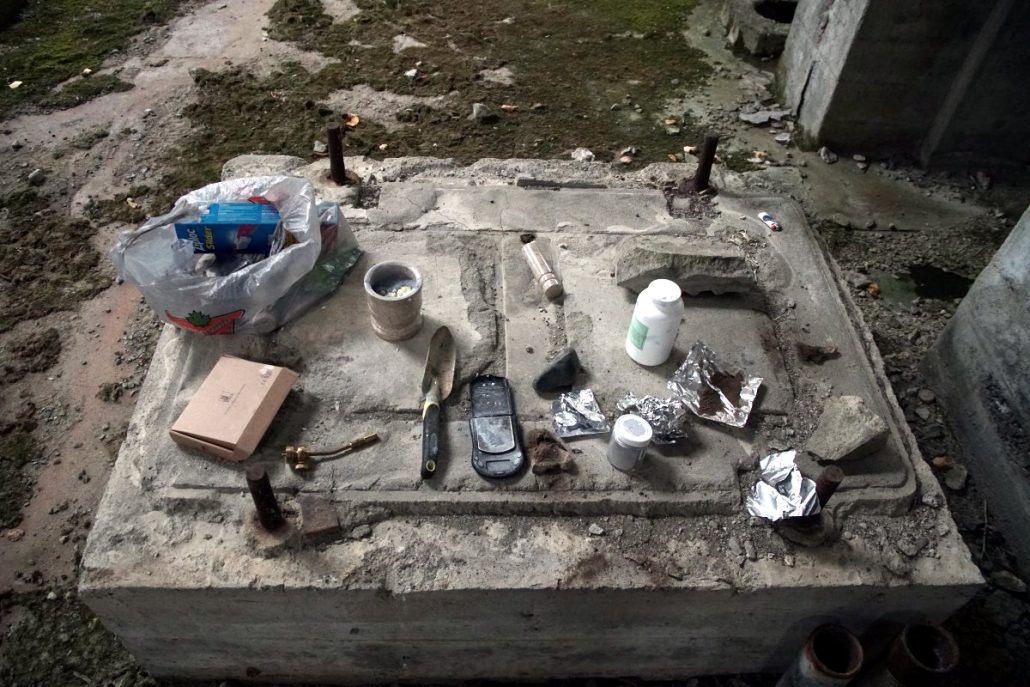
The Speculative Life Cluster at the Milieux Institute @ Concordia will be hosting a workshop with artist Martin Howse.
WHEN: November 17 4-8PM
WHERE: Perte de Signal Gallery (5445 avenue De Gaspé, local #107) http://perte-de-signal.org/en/
Let the waters above the heavens fall,
and the earth will yield its fruit.
Circulation explores the material bases of contemporary media, intervening within cycles of earth-extraction-earth-return in which the minerals which form the material basis of digital technology are pulled from the ground using large-scale industrial processes, eventually to be re-absorbed in the form of e-waste and pollution. The workshop will cross and leak across disciplines of computational culture, logic, geology, alchemy, chemistry and literature.
During the workshop we will discuss, research and conduct practical experiments focussing on material processes involved in extraction (of precious metals for technology) and the dissolution (of technology back into the earth). These experimental situations ask questions about the links between (the) earth and communications/computational technologies. Amongst other actions, participants will: refine silicon and other computational materials from sand obtained from mining sites, culture bacteria involved in processes of acid mine drainage and undertake simple analysis of such matters, undertake the speculative assembly of dissolution-inspired Turing Machines and fluid logic devices.
Please contact antonia at cordltx.org to register.
16.1.1 Information for participants
It would be great if you can bring the following (although not essential) for the workshop on Thursday:
- A small spoonful of dried earth (you can dry it slowly in a low oven or microwave!)
- Any to-be-discarded phones and small digital data devices (desktops, screens, ipads, ipods, hard drives), preferably with some personal connection. These will be dissolved (slowly).
- Warm clothes as we will conduct some parts of the workshop outside.
It would also be ideal for each participant to have a vague understanding of both fluid Boolean logic gates (see for example, http://www.blikstein.com/paulo/projects/project_water.html) and abstract Turing machines (eg. https://www.cl.cam.ac.uk/projects/raspberrypi/tutorials/turing-machine/one.html)
16.2 Call for discarded data
As part of the Dissolutions research project, artist Martin Howse issues a call for the donation of obsolete, to-be-discarded phones and small digital data devices (desktops, screens, ipads, ipods, hard drives), preferably with some personal connection to the donator. These devices will become part of the dissolution process taking place from 15th November at Perte de Signal, 5445 avenue de Gaspé. Donation will also present an opportunity to discuss this process with the artist.
Contact: m@1010.co.uk to arrange delivery times. Or drop by Tuesday - Saturday from 12PM to 6PM. All data on any devices will be destroyed.
17 exhibition

From 1st December to 10th December at Perte de Signal, 5445 avenue De Gaspé, local #107 Montréal, Québec, H2T 3B2. Documentation to follow.
18 documentation
19 credits
Dissolutions is an artistic research residency and exhibition project initiated by Berlin-based artist Martin Howse, curated by Peter Flemming in collaboration with OBORO and Perte de Signal, with support from the Goethe-Institut Montréal.
With thanks to Peter Flemming, all at Oboro, L'Ecart Lieu D'Art Actuel, Kathrin Guenter, Marko Savard (lalumine ceramics), Stephanie Castonguay, Swintak, Diane Morin, Orit Halpern, Jean-Francois Prost, Cynthia Crifar, Bill Lubell, Tim Dallett …
